Text
December ‘20
Bugsnax

Bugsnax is an odd little title, landing somewhere between Pokémon Snap and Ape Escape. There’s a bit less of a frantic pace though, instead telling a tale of a remote island where the titular part-animal, part-snack race roam about, with a series of characters each having their own relationship to them that... typically involves eating them. The disappearance of one key villager has been the catalyst to everything heading into a state of confusion though, and as the new person in town, it becomes your job to pull everything back together, all while trying to piece together a better understanding of just what Bugsnax are in the first place.
The game’s main cast are loud, colourful, and full of personality, with some decent queer representation going on too. It’s regularly quite charming, but the story runs parallel to a pretty simple gameplay loop of going out to a new area, meeting an estranged villager, getting a new tool that allows you to catch some new ‘snax in service of a given task for said villager, that inevitably fuels their return to the village. While catching a good chunk of the 100-strong Bugsnax portfolio follows a fairly repeatable mould of trap-setting and capture, some require some slightly more creative thinking, and final smattering lean more on good fortune as you try and juggle a few different elements in a way that sets up the perfect snaring.
I’ve seen some talk of folks who found the last sections of the game a little out of character, but having gone through all of the side missions before heading for the finish line, nothing came as too much of a surprise for myself. As a PS5 launch game it might lack the flair and experimentation that one might expect, but in better handling one’s expectations and seeing ‘just’ a game with extraordinary timing, it’s a pleasant and sufficiently entertaining romp - just nothing particularly out of the ordinary.
Demon’s Souls

I was in two minds coming into this. I’ve played the opening few hours of Demon’s Souls about 5 times now, with each attempt before this one stalling at different points for a variety of petty and frustrating reasons. So this, a fresh chance to try again, newly polished and smoothed out, with active servers, and a revitalised community? Excellent! Yet on the other hand, how much of the magic is Bluepoint likely to have been able to recreate? Even as a shot-for-shot remake, what if they had diluted the experience?
While I can’t speak with any particular authority here, very little seems to have changed outside of the visual overhaul. Some areas might be a bit easier to navigate owing to their new lick of paint, but enemies still pose the same threat, and everything is still where it should be, as are the obtuse, woefully under-discussed karmic swings that underpin its tendency system. Let’s not pull punches; it’s most notably a mean platform to build a game upon that makes suffering players suffer more, and is likely not one that you’ll even be aware of it before near irreversible damage is already done. From have undoubtably done similar concepts much better since, and while I might bemoan it, there’s also something to be said for allowing it to still exist just as it did at the series’ outset. It’s likely a wise choice on Bluepoint’s part to have left it untouched, albeit a slightly cruel one.
While the lack of a single, interconnected world was not yet on the cards for this particular Souls outing, there’s still plenty of great level design, with each of the game’s archstones providing a theme that’s adhered to brilliantly. A few exceptions aside, boss battles are typically less about flexing combat chops too, proving more of a challenge in solving how to approach them in the first place. In doing so, it creates some truly memorable moments alongside those that are purely frantic and rewarding thereafter. The same can be said for the game at large too; while its punishment of new players might be its most infamous quality, it does do a remarkable job in having you learn its every inch, and how best to deal with everything it cares to throw at you. While the chase of 1:1 replication might mean some of its jankiness remains, its visual overhaul and silky smooth frame rate certainly do a good job in helping you overlook it all and in embracing the still best-in-class world building. One of the years’ best, and by far the most compelling reason to date for next-gen ownership.
Grindstone
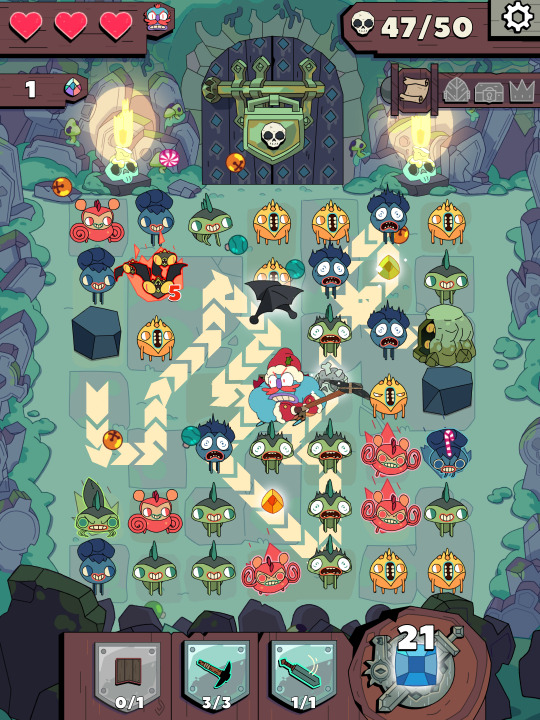
Grindstone was front and centre right as the doors opened on Apple Arcade, and it’s a pretty easy to see why it’d be pegged for such honours. It’s bright, colourful, charming, and very easy to pick up. Some of Capy’s other noteworthy titles might fall more into the realm of the arthouse, but this is them at full power, exhibiting that ultimate strength of knowing just how to capture any given audience. Most of the game is spent planning out your turn, and it looks great even in this calm stillness - but as you unleash the mighty Jorj on each of his rampages, there is a satisfying spring into action that gives the same kind of satisfactory twang you might get from an elastic band, or a coiled slinky about to bound down a flight of stairs.
Within a few short stages almost all of the base mechanics are laid bare, with each turn asking you to plot a course through colour-matched enemies, and landing you far enough away from any enraged enemies that’d seek to do you harm. Chain for long enough and you’ll spawn a grindstone that’ll let you switch colours mid-combo, and building up enough hits can then allow you to expend that strength on monsters with higher health pools. The range of enemy types grows as you progress, as does the array of new tools you can build that allow you new ways of dealing with them all, but ultimately the balance that needs addressing is knowing just when to walk away. There’s typically three goals to each level - opening the exit being just the first of these - and while in some cases you might have a handle on things when the exit does open up, it’s often not the case, and hanging around too long carries the risk of losing all of your progress on the stage if you lose a clear path to your escape.
Some of its later mechanics and the level arrangements can be quite taxing, and while never completely unfair, it can definitely... grind... on your patience. For something that could easily be taken as a casual little puzzle game, it’s quite lengthy too - the path unbroken leads you through a whopping 180 stages, but without extensive draining of resources from each of these, you’ll likely need to try some of the side dungeons to help make your way to the end too. Very likely more than your bargained for then, and yet still plenty compelling to boot.
Necrobarista

Some neatly constructed character models and a snappy trailer might attempt to tell you otherwise, but let us be clear with one another that Necrobarista is very much a visual novel. A shock to the system this may be, but anyone reading this likely knows by now this is far from a bad thing around these parts, so let us look a little closer.
It’s quite a melancholic thing, set in a less than conventional, somewhat Purgatorial coffee shop, where the newly departed stop in for a brief spell and a brew before taking the next step into the great unknown. While there’s a setup here for lots of stories to be told, it really draws in on a small cast of characters who look after the shop, and how a few key visitors change the world built up around them. Between each of the game’s chapters there’s the opportunity to unlock new side stories dependent on which of the phrases you chose to identify with from the chapter just gone, and although short, these do some good work fleshing out some characters and breaking up the main tale. As the title would suggest, the particulars of coffee do come up as a point of conversation, but there’s no drink-making side shows here - just a lot of talking, scheming about how to cheat death, and the more chin-scratching topic of a more accepting approach to this great inevitability.
It’s fairly short - comfortably under 10 hours - but crucially gets plenty of character development from each of its cast given the tight focus. Rather than the still portraits that you might come to expect of the genre, characters are given a real depth with 3D models that convey just as much as their words, which also helps this effort. Perhaps most crucially, and whether it’s in spite of all of the death, or instead because of it, there’s plenty of quite thoughtful and heartfelt sentiment hidden inside it. Comes recommended.
Tangle Tower
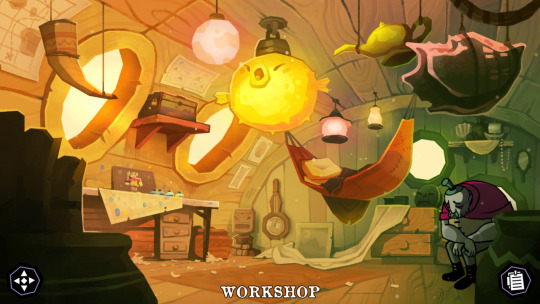
I picked this up for Switch based on a recommendation, not knowing that I’d unknowingly be closing out an Apple Arcade hat trick for the month. So yes, it’s another more story-driven game, not too heavy on the input requirements, but instead good for getting you thinking.
It’s immediately very easy on the eye, with each and every character drawn in large format and animated with buckets of quirk and charm that runneth over. Every single one is brilliantly voiced too, with varying degrees of charisma, bluster, dry wit, and numerous other characteristics that shine through in brilliant harmony with the art. It’s a murder mystery, see, and while you’re putting together what everyone says has happened, looking out for who’s fancying who and the like, you’re also doing so with the critical expectation that at least one person is likely spinning you some tall tales. Luckily you’ll find clues that help you get closer to the truth and help deconstruct some of these falsehoods, whether they’re in plain sight or hidden behind one of many puzzles. These are exemplary in just how well-pitched they come, each being self-contained and just tricky enough to have you pause to really think about them, but without ever being too irksome or troubling to stop you enjoying yourself. Once you do start to get to the point of unmasking some secrets, there’s also a neat little interface the game rolls out for you to drop in and then verify these revelations; pairing numerous characters, items and statements to help demonstrate to it that you’re keeping up with it all, and things are clear enough to move on. There’s subtle little prods in the right direction just when they seem to be needed, further cementing the game’s solid grasp of when it’s best to say something, and when it can let you just stumble about and get on with it.
It’s a fantastic little game. I lost a day or so to this, and had a wonderful time doing so. I hope that it’s not too far away that I forget all of the details, so that I might do it all over again.
5 notes
·
View notes
Text
November ‘20
Cross Code
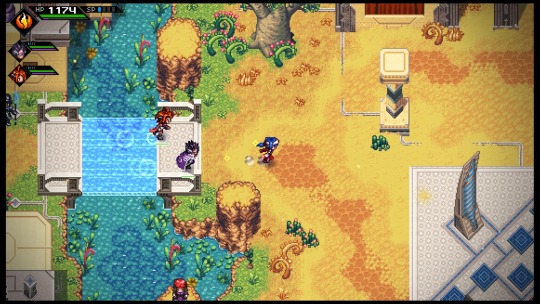
Cross Code is a game that is trying so very, very hard. The story is based around your character being an avatar within an MMORPG, and its this kind of game-within-a-game setup that is used as a cheeky way to skirt the fourth wall and have its characters make snide remarks at certain design decisions, while also going full steam ahead with them regardless of the fact. Don’t think we didn’t notice, dev team! It plays out as a 2D top-down action RPG, but clearly has aspirations that extend far beyond this framework. Each of its environments is thoroughly layered with subtle verticality, with parkour-esque platforming having you constantly working backwards from your intended destination, and requiring meticulous attention to detail in order to find where it is you’re able to begin your elaborate series of jumps from. There’s a huge array of materials to gather and channel through traders and to craft into gear, and the combat they benefit is both precise and complex, requiring plenty of on-the-fly thinking as well as tight execution. As well as these set-piece battles, the game’s dungeons are full of puzzles that though smart in construction, are tough enough in isolation, and frankly brutal in their relentless frequency. One particularly ill-advised chapter has a series of three such dungeons in quick succession, and perfectly illustrates that just because you can, does not mean that you should.
On a more positive note, one thing the game does have in spades is charm. The sprite work is admirable; even though characters are a touch on the tiny side to be too effective on their own, their portraits and dialogue provide a solid emotive connection to them and the story that builds up around them. In all, it is a game that can be a lot of fun, and plenty rewarding - but the entire thing is overly long and far too regularly punishing. It’s tapped into a number of 16-bit action-RPG ideas well, but has perhaps unintentionally also managed to become the most masochistic presentation of these ideas to date.
Crimzon Clover: World Explosion
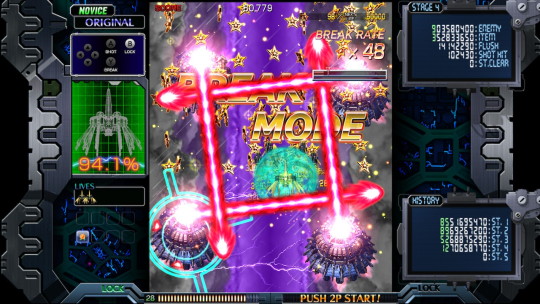
A game I’ve technically owned for years now, however the lack of a Windows PC has held me back from playing it - with this debut on the Switch finally granting me the opportunity though to get hands on. Although I’d gleaned plenty from watching super players decimate it before now, even my feeble credit feeding through the game’s five stages has given me plenty of additional appreciation for just how good it is.
It looks brilliant, with chunky, detailed enemies animated beautifully as they move about the screen. The music pounds along to an energetic beat, and the game keeps a solid pace all while plenty of bullets swarm around you in creative and considered patterns. Turning the tides with Break Mode is an incredibly satisfying way to take control of hairier moments, and while I can’t speak for every intricacy of its scoring system, I know that it’s developed by a team that demonstrably understands the value of these. What I can more reliably add to that discussion is that you’re unlikely to find yourself reliant on any one hook to find your fun though; even the most pedestrian appreciator of the genre should find plenty to enjoy. Thoroughly deserving of its regular appearance alongside the biggest names in the genre.
Holovista
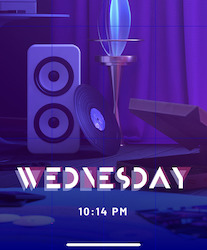
There’s often a reasonable amount of scepticism that comes from some folks when you talk of gaming on a mobile phone. Flipping the conversation though, and instead to talk of one of my favourite advantages of the format, it’s great that a developer can lean on the familiarity and the personal connection that you have to the device you’re playing on. As a device that lives by your side 24/7 and increasingly encroaches further into every aspect of your being, Holovista leverages this connection amazingly, spinning its story in a series of interfaces that mimic how your phone acts when you use it yourself. Taking pictures and interacting with people in particular are key interfaces, and that are done in a way that neatly puts you right into the shoes of their character.
It begins with said character taking an interview for a new job that is hoped to herald a new tide of good fortune, and promptly introduces the circle of friends that are there to help with this and that celebrate alongside. As you learn more about the job, things slowly begin to get a bit weird, and then take a turn that is something akin to Black Mirror meets nightmarish introspection. Though not overtly unpleasant, there are some memorably unsettling moments along the way. Sensibly, it does have content warnings that offer some sound advice for those it might not sit so well with, but self-care does end up being a central takeaway from the game as a whole as well as for its cast. On the back of circumstances we’ll generically chalk up to this year’s being what it is, this ended up feeling like a lovely little palate cleanser - a considered refresh, thoroughly original, and a very worthy afternoon’s entertainment.
The Legend of Zelda: Link’s Awakening
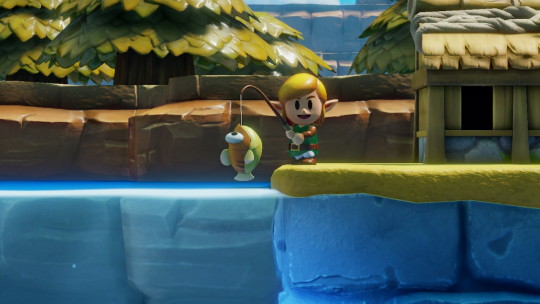
One thing that’s always been great about Link’s Awakening came as a result of the technical limitations imposed by the Gameboy - that the Zelda format needed all the fat trimmed, while the mixture of puzzles and action were to be distilled down into their most potent and compact form. Even with the (entirely optional) extras they’ve slipped in with this remake, this still shines through in its design now, where it couldn’t be any further removed from the risks of overly long, dragged out pacing. A small overworld it may be, but it’s full of variety, secrets, and memorable moments. Dungeons are similarly economical with its good ideas - giving you new tools, laying out smart ways to break you into their use, and then letting you get on with things.
While the remastered music is also utterly charming, the real upsell here is the total visual do-over; its tilt-shifted cartoon aesthetic pushing each and every scene to look like a shiny, hyper-cute diorama. For all of the different visual styles that the series has dabbled with in the past, this one definitely feels like the right match for the light-hearted whimsy that comes through from the story and the characters. That’s not to say that it’s flawless either - the blurring at the screen’s edges can be overly intense at times, and the overall presentation does cause the performance to stutter and feel a little sluggish at times. I point at these things only given the bar is raised so - something unavoidable when you already know a game is a stone-cold classic from the off.
Astro’s Playroom

Coming pre-installed on your shiny new (and hopefully not scalped) Playstation 5 console, Playroom begins as a humble introduction to the capabilities of the Dual Sense controller. Touch control, haptic feedback, adaptive triggers and the like are introduced and may well generate some cooing and low-key positivity, however this enthusiasm is elevated by a mighty factor when the game truly begins and everything is put so deftly into practice.
It’s not a complex or particularly challenging title as far as 3D platformers go, with frequent checkpoints and no life counter in sight. Any mould-breaking to be done comes instead from the diversity in how you control various sideshows, with the entire kitchen sink’s worth of interface options being showcased as you climb into a monkey suit, blast off a rocket ship, bounce around as a pinball, and so on. All of these demonstrate ingenuity that could’ve easily gone awry, yet are quickly understood, and grounded in a level of both tactile and in-game feedback that maintains a natural feeling. The game’s worlds serve as virtual tours through colourful, fantasy depictions of hardware components that demonstrates an excellent level of both pride and playfulness, with fellow bots littering both the through-fare and the unbeaten paths, dressed up and enacting smart homage to generations of games and their characters, all while Playstation-themed collectables are doled out in tandem alongside smart, well-natured puns. It arguably borders on propaganda at times, such is the intense positivity. That said, the more extensive your tenure is with Sony’s platforms, the more likely it’ll dull your better judgement to this, instead letting slip a grin at what is essentially the grandest love letter to all things Playstation, and the warmest, most celebratory pack-in for a new console Sony could have ever hoped for.
The showcasing of new features and hardware aside, it’s also a subtle and unofficial coronation of Astrobot as Sony’s newest (and best) mascot. There’s been plenty of candidates in the past who’ve half-heartedly assumed to own the position, but it’s the silent, cheerful charm which makes Astro that much more of an endearing figurehead. G'wan the little guy.
No More Heroes 2: Desperate Struggle
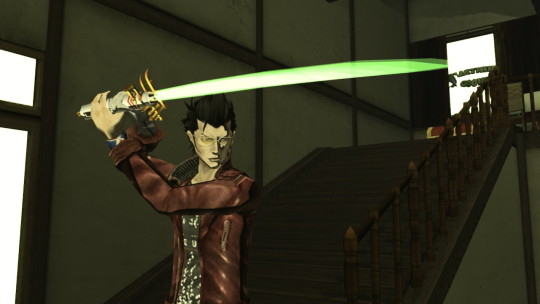
For someone that loves Suda51 and adored No More Heroes, my reaction to No More Heroes 2 on its original release was comparatively tepid. With a third game due next year, this re-release felt like the right time to revisit it and see it through, and although I found some things to enjoy, I certainly found plenty to remind me why I had bounced off it previously.
Roaming about in Santa Destroy between missions is gone, instead replaced with a short check list of destinations. While not a fan of the change myself, this isn’t necessarily a bad thing - though it does give a misleading impression of tightened focus that is very quickly lost as it lays out a spread of half-baked, and frankly clumsy mini-games. As well as being your prime source for money and upgrades, these do a lot to artificially increase the length of the game, and put simply, they’re just not fun enough to warrant this level of prominence. Even the main story has frequent moments where it veers away from the core 3D hack and slash gameplay, and again, these do more harm than good to the game’s flow.
The fighting underpinning it all has undoubtably been done better since by any number of titles, and though imperfect, it is still serviceable and enjoyable for the most part. Boss battles definitely hold the lion’s share of the game’s highlights, but there’s a few that also stick out with some poorly executed designs that tars its lasting impression. Shades do remain of the ridiculous, irreverent charm of the first game, although they are certainly more infrequent, and a more modern lens also brings into question just how sincerely we should take the sending up of Travis, when cast upon a backdrop of frequent fanservice. Not the best sequel then, but let’s hope 3 gets things back on track.
3 notes
·
View notes
Text
October ‘20
Hades

Hades is a great roguelike for people that don’t like roguelikes. As you start out, you may be back to the start again frequently, but as well as taking the smart step of making the beginning one of the most endearing parts of the whole process, it also rarely lets you leave on your journey without some kind of permanent upgrades in tow. This tweak to how the genre typically plays out may not be new, and could almost be taken as a gap in its armour, if only it weren’t so effective and damned confident in every other facet of what it does.
Combat is very much at the heart of it, with a variety of fundamentally different (and yet all entirely viable) weapons being just the foundation of the ways in which your play style is catered to. Movement is quick, smooth, and satisfying, and clearing rooms feels good even before you’re then offered a reward. Some of these fulfil the role of currencies that can be used back in the house of Hades, while others are more focused on trying to improve your chances of survival this time in particular, through either direct changes to your weapon, or God-granted boons that help shape your build in their image. As you progress you’ll find even more ways to diversify your loadout, and with so many of these layers being randomly generated each time, there’s an impressive breadth of diversity that goes far beyond the procedurally-generated level layouts and your chance encounters within them.
Sitting atop all of this is a rich and dense story, neatly crafted around Greek mythology. It’s drawn out to match the longevity of a soap opera, yet somehow retains a momentous level of quality in both the writing and the voice performances. Minute details of your tragedies and triumphs are pored over in frankly stunning detail by the characters you interact with, often linked with changes that are then reflected in their behaviour during your runs, and then reacted to once more when you get back to them again. Aside from the sheer number of conversations to have with them, there’s plenty to love in each of the characters - they’re charmingly presented in both the art and and the performances that bring them to life.
Even once I’d reached the point where winning became more of an inevitability than a lofty goal, I still found myself enthused by each trip back to the start - raring to go, armed with new stories to unravel, new upgrades to pursue, heightened challenges, and new kit to play with. The level of all-over polish is rarely seen to begin with, and to do so when the volume of game is as substantial as it is here is frankly staggering. Bravo, Supergiant - this is really something quite special.
Hide & Dance!

A rhythm game spin-off of an already quite esoteric title - Hidden my Game by Mom - seems just the kind of thing that’d get my attention, right? Diving right in, it’s pretty simple as far as rhythm games go, with four basic inputs mapped to d-pad and face buttons. The unique addition is in-keeping to the theme of the original game, and has you constantly keep an eye on the door behind you - spotting when it begins to crack open, and right on cue, pressing the L and R buttons to avoid your family, before then resuming your throwing of shapes. That said, ‘avoid’ is a catch-all term here, and every character has a variety of daft poses, dodges, and deceptions that all fall under this header, the only connection being the their crucial suggestion you’re doing anything but dancing. These are totally ludicrous, and often hilarious. Please: see above.
Songs are cheerful, upbeat, poppy numbers, and typically are under a minute in length. See, it’s not trying to set the rhythm game world on fire, but it is charming, pleasant, and even a little challenging once you start to crank up the difficulty. The smattering of songs you start out with is quickly bolstered with an in-game store (see: gachapon machine) that doles out characters, songs and sound effects - though it really doesn’t take long to clear it out and have the complete collection available to you either. It’s not essential, but it’s a modest, and modestly priced, diversion that’s worth a glance.
13 Sentinels: Aegis Rim
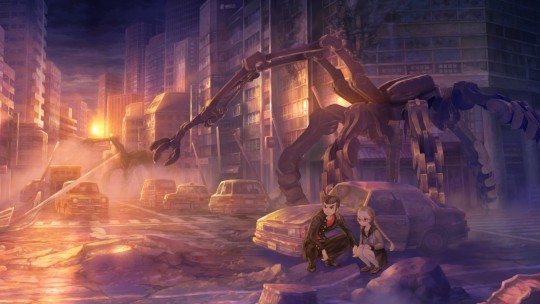
Even with the heavily-cliched setting of teenage school kids piloting giant robots and being pitted against cataclysmic invaders to preserve the fate of the earth, anyone who’s familiar with Vanillaware, or more specifically, the work of George Kamitami, will still easily be able to identify his work. His art is as beautiful as it is recognisable, and with the more sedate story sections of the game panning, scaling, and dynamically lighting all of this, it’s certainly quite a striking thing to look at.
Yet, the visuals aren’t the most over-reaching part of the game by any stretch. The titular 13 sentinels are manned by the 13 central characters, who each have their own little narrative arcs for you to see through. You start off with a small selection of them, but you’ll soon be expanding your horizons and juggling the full roster, choosing which angle to tug the narrative threads from. A whole other layer of the game is arguably the most game-y bit of the package, leading the sentinels more directly in real-time strategic battles. These sections are more fun than I’d expected; different sentinels have different skills and strengths that must be played to, and effective use of upgrade materials between fights are equally satisfying to put into practice. There’s even more storytelling at the beginning and end of each of these fights too, and balancing these two main parts of the game is left entirely in your hands. Your progress on all fronts is clearly tracked and visible throughout, and although you’re very like to come across a roadblock on one side, the game is always very open about what’s holding you back and needs to be done first to prepare you for the next big revelation in the story.
In truth, the story is a little bit too ambitious - given the number of characters, the complexity of its scenario and sci-fi concepts, and the likelihood of out-of-sequence dipping in and out of each story, it’s very easy to lose track of what’s happening, or even worse, the desire to keep up with the details. Thankfully, the overall mission is straightforward and compelling enough, with plenty of good moments to propel you forward. Backed up with great art, and an impressively competent battle system underpinning it all, this has turned out to be the first Vanillaware game that I’ve ever been inspired to see through to completion.
5 notes
·
View notes
Text
September ‘20
Paradise Killer

Putting it out there front and centre that I know some of the folks involved in creating this, and clearly I’m devoid of sufficient integrity to be impartial. You know, it’s best to get these things out there, with the internet being what it is.
It’s a whodunnit set in Paradise, with your character having been brought back from exile and tasked with solving who’s responsible for the mass-murder of the island’s core council. There’s a clear set up with one guy already due to take the fall, but it quickly becomes apparent that the island’s populous of weird deities - who perhaps have too much time on their hands - clearly have more of a stake in this than they’d like you to know. You’re left to investigate at your own pace, poking around crime scenes and places of interest, but also soaking up the island and its vibe as a whole. Getting reacquainted with its residents is a massive chunk of this, and if their out-there names, colourful outfits, and eccentric behaviours weren’t enough to draw you in, there’s more serious manners such as allegiances and motives to start peeling back the layers of. Titbits of info gleaned will often give you the opportunity to eke more out of someone else, and although the game does a great job of subtly nudging you to where loose ends might best be chased down, you’re given the freedom and ultimate responsibility on when to start wrapping things up at trial.
Given the potential for disorder in its narrative structure, the game’s job in cataloging all of your gathered information is crucially neat in its execution. The free rein that allows you to be as orderly and meticulous as you choose is welcome, as is the gentle push towards the truth of things. But there’s also just enough space to sink into convenient falsehoods - even to present them at trial and make them stick, if you can pass on that conviction - and it’s this freedom that really sets it apart from its contemporaries. Helping this is a fully realised island you can move about in and investigate, rather than doled out chunks of exposition by chains of talking head sequences. More salacious secrets are typically locked behind puzzles or specific items, but there’s also a particularly inviting nature to the architecture that suggests playful acrobatics - dashing, double-jumping and the like - be used to explore out-of-reach areas.
The look is tinged in pinks and blues, giving a suitably welcoming glow to Paradise. It’s warmth is helped massively by the soundtrack that runs throughout it, bringing pleasant, jazzy saxophones and subtle, warm electronics into its city-pop inspired stable. There’s a great voice running through its veins too - one that operates in its unspoken thoughts, the descriptions of its collectables, even the interface and the sub-headers as you enter new areas - just about damn everywhere. It’s smart, it’s cynical, and it’s snappy, and is a regular factor in keeping a smile on your face even in the moments that get closest to being downtime. Bias be damned! I can say, hand-on-heart, that it’s a game that not just nestles in comfortably among its peers, but stands tall among them.
Moon

Cult status can be a double edged sword. For anything cult - movies, albums, games, you name it - there’s that risk that if put under a modern lens, they can be painfully of their time. Cherished by those that were there, perhaps, but impenetrable - or even worse, alienating - for those without that context. Previously a Japan-only PS1 title, Moon has held such status for 20+ long years, but on its return, lets you know very quickly that a lot of what it had to say was timeless.
Its sending-up of RPG tropes is pretty spot on - the game-within-a-game that your character boots up got a big belly laugh out of me almost immediately, and then leads into a montage of a hero’s journey through a world that you’re then later transported into to pick up the pieces. See, the ‘hero’ in the game is kind of a jerk - barging into people’s homes, taking things out of their cupboards, killing all of the wildlife, and so on - and while this likely sounds very familiar, Moon prompts you to remove that filter of normal game behaviour, and instead asks that you try and be a bit more conscionable and pleasant. Acts of kindness to others are repaid in love, a tangible currency that grows your love level, allowing you to spend more time in its world before you need to rest and begin your day’s busy-bodying anew. Observing the routines of the world’s inhabitants is key to making good on its many grievances, and although these are straightforward enough at the start, some of the later challenges relied on some more tenuous thinking - to which, I’ll put my hands up and say that I turned to a walkthrough. These more patience-testing moments might have been a good way to pad things out in ‘97, however it’s a bit steeper an ask today, when I daresay most people will be visiting this as more of a curiosity. Accepting a helping hand doesn’t stand in the way of these scenarios delivering on the charm, surprise, or humour they originally aimed for, though. Labelling it a parody or a spoof might work as a descriptive shortcut, but it’s never mean spirited, and clearly loves the subjects it pokes fun at - there’s a wonderfully self-effacing humility throughout it.
Given Final Fantasy 7 - often cited as a common entry point for many modern western fans of JRPGs - didn’t even arrive in Europe until after this originally released, it’s not hard to understand why it wasn’t considered for localisation at the time. The audience certainly didn’t exist at scale, and simply wouldn’t have had the gaming experience or vocabulary to appreciate it. Not only can we now better appreciate it as the tongue-in-cheek love letter it is, but the message of compassion and thoughtfulness is something that’s more essential today than arguably ever before.
Spelunky 2
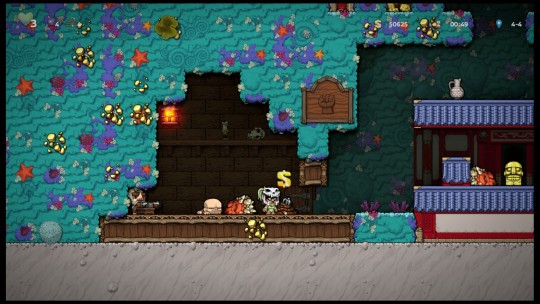
This was always on my radar as a likely ‘game of the generation’ contender. I’ve been playing the original game on and off now for around 8 years - it’s followed me as a regular part of my gaming diet across 4 different platforms, and crucially, all the way up until the night before this finally landed on my PS4. Without getting too philosophical about it, it’s a very important game to me. Despite all of the time playing it, thinking about it, talking about it, or even reading the gosh darned book about it, I never once thought to assume I had the answer for what would make a fitting sequel. Thankfully, the team behind it had more ideas, and the faith in their convictions.
All of the crucial components of the original are here in abundance, and added to with a restrained modesty. Its randomly generated levels are more complex, and offer more distinct ways of hiding secrets, all while a subtle but slick graphical overhaul does great work in making them look more organic than ever before. More complex fluid physics allows for more transformative ways of opening up levels, and mounts might add some quirky new dynamics to things, but crucially, things under the hood beside this remain largely the same.
Perhaps more importantly, Spelunky 2 understands the fervent player base centred around the original game, and uses their knowledge and familiarity to challenge them anew with clinical precision. Things are just similar enough: the title screen, the tutorial, many of the enemies, and the stages that you find them in - they’re tweaked, yes, but still familiar. On top though, there’s enough that’s new, or changed in a minute yet specific way that makes it very clear that things are going to be uniquely dangerous all over again, and that your muscle memory is more of a liability than a crutch. The curve of learning the game - understanding and tempering its dangers, and the slow, cautious, pulling back the curtain of its newer secrets - is still pitched in the same utterly compelling way as before, though. Rather than being harder outright, or just more lumped on top, it finds a way to make new players and familiar faces alike to learn to play Spelunky all over again, and it’s a total joy to have that opportunity. It’s everything I didn't realise I wanted in a sequel, and it’s breathed a new lease of life into a game that I wasn’t even bored with in the first place.
Tony Hawk’s Pro Skater 1 & 2 Remastered

The original THPS was proper lightning in a bottle stuff; while its countless sequels eventually drained every good idea bone dry, and it left countless half-baked spin-offs in its wake, it’s hard to be mad, or surprised, when the original formula was so potent. Underpinned by a brilliant combo system that called back to arcade-style score chasing, in tandem it also nailed the kind of goal-based mission objectives that became so common after it. This is before you even get on to the way that skateboarding’s irreverence, fashion, and music were curated and presented in such a way that they left a mark on an entire generation. Sports titles are often glossed over from a critical perspective, but there is no escaping the quality and impact of this series.
This remaster tries to capture it at its zenith - and although they’re arguably off by a game or two, depending on who you talk to - it’s generally welcome that some of the ideas from later games are pared back. What it does with these first two games is for my money, the gold standard of what a remaster should do - it makes them look and feel like you imagined they did at the time; smooth, detailed, and responsive. Please, don’t make me go back and look at what the originals actually did look like, because I don’t think my poor brain could take it. The kitchen sink has been thrown at everything surrounding the game, with more relevant and diverse skaters brought into the fold, menus upon menus hiding a wealth of additional challenges, and a soundtrack that celebrates the older, punkier roots of the game, but also shines a light on some musical features that are perhaps more relevant to today’s youth. It’s all handled with a surprising elegance.
It’s a great new way to introduce the series to people, and also a nice outlet for old hands, with my only real criticism being that I had blasted through both of the original tours within a day of dropping the disc in my system. Yes, I could chase high scores endlessly, and yes, there’s a park builder and an abundance of multiplayer modes - but if you’ve finished these games before and just want to revisit them with a new lick of paint, don’t be surprised when it dries out fast.
0 notes
Text
August ‘20
Ruiner

Ruiner frames its action at an isometric tilt. There’s a lot of red; in the game’s interface, as the prominent colour of the neon lighting that adorns its stages, and in the blood that is frequently spilled. Its cyberpunk setting isn’t anything particularly new, but as a unifying aesthetic, the glitchy effects, and out-there personalities doing their best to cope in a dystopia do well to build a convincing and intriguing world. Stages are action packed and throb with electronic noise and big loud industrial bass hits, with the play being akin to an arena shooter; enemies surging at you in bite size, minute-at-a-time waves, with each of these closing out with a grading screen serving as the pat on the back to keep that dopamine rhythm pulsing. It’s a pretty hypnotic cocktail.
These stages evolve out of a singular hub city, and while it’s not particularly big, there’s just the right level of hubbub, and it has a lovely Hirusawa Susumu track acting as an excellent, melancholic mood-setter. Based on the size of its world and the the quick-fire action being split between a very small number of stages, it’s not surprising to say it’s fairly brief - I mean, how could it get so big? But what is important is that it’s plenty of fun and and has style by the bucketload. I got a good kick out of it.
Carrion

On one hand, a horror game where you play the horror is just the kind of flip on a genre that’s needed to freshen things up a bit. On the other, it’s one straight out of the spoof ‘Peter Molydeux’ playbook. What a carri-on.
... I’m sorry. After your initial escape from a lab, Carrion centres around a hub world, with individual stages then breaking off to allow for more specific themed stages. What you’re trying to do within these is to spread your big, goopy self around, where certain spots will act as save points but also count toward unlocking an alternative path back to the hub and opening up new routes in the process. What’s unique to this particular metroidvania take is that while there are new skills that open up new routes, your movement in general is uniquely freeform - point in a direction and off you go, free of any worries about platforming and the gravity that’d otherwise bind you. While it may not be the most precise movement given the size to which you grow - and boy does this become a point during some forms of combat - it does remain responsive, and quite fun to simply shamble about like a giant congealed blob of bloody, multi-toothed sinew-y mess. Everything scales up nicely on both sides of the fighting, with distraught pistol-equipped humans turning to shielded folks with flamethrowers, all the way up to drones and mechs that are just as mobile and / or deadly as yourself, even in spite of your own upgrades that allow for more ranged, varied, and sharper extremities. It’s not especially long, and is never so taxing as to demand too much expertise of you, but it is fun and importantly, quite unlike anything else out there.
Yoku’s Island Express
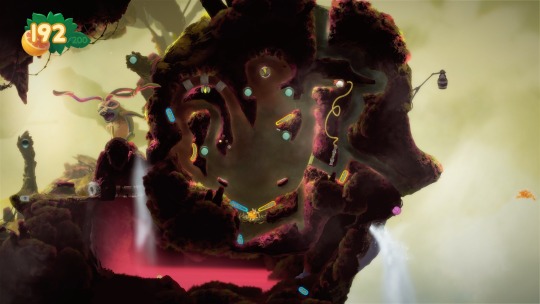
Pinball continues to feel like a lost art form to me, with the nuance of skilled play being more like a foreign language than another type of game you can easily pick up. Yoku, newly-appointed postmaster, is but a tiny little bug, and as such is indebted to these skills in his efforts to travel and clamber about an environment much larger than he. Flippers are casually littered about to shoot you from one area to the next, but there’s also plenty of sections you’re led to by the story that are small yet just detailed enough to play like a neatly sectioned off area of a complete table - complete with requirements for precise shots to move forward, and those inevitable moments where you have to sit back and watch as your ball falls with miserable, exacting precision between the flippers. Failure typically sets you back a few pickups, but given these are just as quickly re-earned, you’re never punished too hard - there’s certainly no three strikes and out mentality here. It’s a very friendly interpretation of pinball’s mechanics, and there’s a decent enough story layered on top, with its characters and art demonstrating enough pleasant charm that you can definitely see this being a great way to introduce pinball to a younger audience. That’s not to say it’s not enjoyable from an older player’s point of view - just that you know what’s being presented is a wisely palatable version of a classic hobby, rather than the arse-kicking ordeal you may be used to.
Rime

I am certain that Rime would love me to compare it to a certain Fumito Ueda PS2 game. There’s the ultra-minimal scene that’s set as a boy washes up on an island; a sparse, beautiful, somewhat Mediterranean set of landscapes, and with very few ways to interact with it all that don’t involve clambering over things or shouting out in wordless desperation. But as you’ll have noted, I haven’t found it in myself to justify using that game’s name here.
As much as I wanted to give this a chance, it often felt directionless, uninspired, and at worst, slow and tedious. The puzzles are derivative of any number of games I’ve played before, and the biggest danger is that you might assume as to their difficulty and over-engineer your approach, rather than not be able to tackle them. The platforming is simplistic and regularly drawn out with ledges, ledges, and more ledges to climb across and dangle from; even if you were to find a way to fall to your doom, as is tempting, it is unlikely to take you back much further than a few seconds. Crucially, there’s really very little to sink your teeth into on any front, and even when the game does finally start to weave some plot threads into the game’s canvas, it’s well into the latter half - long after I’d already racked my brains for any hint of an allegory that’d fit, and given up on expecting one. Sadly, to the point that the actual story felt like a cheap afterthought when it did finally start to unravel. This bounced off me much harder than I’d expected - I came away wishing it had forged a bit more of an identity and a purpose rather than just an aesthetic strung together with some weak elements of play.
If Found

As far as interactive elements in visual novel-type games go, If Found has a different approach to most. The story’s primarily told by means of a diary - one that’s full of witty observations, personal reflections and enigmatic sketches - that you actively erase as a means to push events along. The diary belongs to Kasio, a trans girl returning to their small Irish hometown after a stint away at university in the city; a return that’s not met in the warmest or most understanding fashion. As a mechanic, the erasure of this diary is loaded with meaning; peeling back layers of a scene often matches a more poignant set of observations, and the scrubbing of such personal details away offers a painful reflection on an identity being chipped away at. It’s very much a story about finding one’s self, about coming of age, and as it rides these highs and lows it does an excellent job in making you ride along these alongside the characters, and it does one hell of a job to make you think about the compassion that you both see and offer in the world outside. I’ll put my hands up and say that there are some elements of the story running in parallel to this main one that didn’t gel with me quite so well, but this is a minor footnote to an otherwise highly enjoyable play through. In a short space of time, Annapurna have done a great job in winning me over with their publishing choices - particularly in holding up the kinds of voices and ideas that fit these smaller titles so perfectly.
Double Kick Heroes
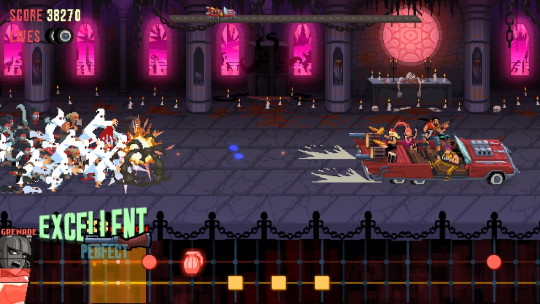
It’s a rhythm game. I like rhythm games! It’s about a zombie apocalypse. Oh no. It’s... a heavy metal rhythm game? Ok, maybe we can work with this.
After a trailer name dropping a bunch of familiar artists - Jinjer, Carpenter Brut, Gojira - what surprised me straight off was that none of these licensed artists featured in the game’s story mode. They’re all sectioned off in a separate menu, and while on the bright side they’ve each given a unique stage with a visual theming in keeping with the bands in question, it feels like a bit of a missed opportunity. Instead, all tracks throughout the story were composed by just one person, and with only a small handful of featured musicians being included to diversify things. It starts with more (arguably) palatable hard rock numbers, but goes up to and includes grindcore, death metal, black metal and the like, meaning that not only is it going to put a lot of folks off right away, but that it’s asking a heck of a lot for one composer to cover all of these sub-genres with the appropriate care. While it was refreshing to hear some types of music I’d normally not expect to hear in a game, some tracks inevitably grated, and while I enjoyed some others, I wasn’t ever bowled over too strongly either.
The story itself is fairly by the numbers. It sees an on-tour band fighting back against a zombie uprising, and has unsubtle references to any number of heavy artists, albums and songs shoe-horned in at every opportunity. It also bears the hallmarks of its dialogue being written by someone that has a very particular sense of humour which personally all fell very flat. While the team undoubtably do love music, the over-enthusiastic style rubbed me in a similarly uncomfortable fashion as Jack Black does regularly, with his half-comedian, half-musician schtick. The gameplay itself is based around the drum parts of its songs also corresponding to different weaponry on your car that holds the hordes back, and while this on its own can prove tricky, higher difficulties also mounts other expectations - like steering your vehicle, or alternating pedals to shoot different parts of the screen. Some of my frustration with all of this is likely my own fault for having chosen to play on the ‘Hard’ difficulty, but traditional wisdom feels a little bit lost when you can still get damaged when your combo meter is racked up well into triple digits.
In all, Double Kick Heroes presented some pretty unique gaming scenarios; like having to work out the best controller configuration to play blast beats with, or asking out loud “did I just hear the words ‘we are Genital Absolution’ coming from a Nintendo console?”, and it’s clearly a small team working on something they really care about. I respect that. I didn’t enjoy it as much as I was hoping, but I hope they’re proud of what they’ve created.
Manifold Garden

A puzzle game taking significant inspiration from the works of M.C. Escher is a pretty good starting point in my eyes. It being presented in a wonderful manner certainly doesn’t harm either; from the UI all the way into the game, it’s beautifully clean and defined, opting for delicate shading rather than messy textures, and with its intricate, recursive geometric patterns, you’ll likely find cause to stop and take stock on a regular basis.
One button looks after your basic interactions with the world (pushing, picking up, and so on), with your other crucial way of interacting with the world being the ability to approach a surface and then assign it as ‘the new down’ - spinning everything about an axis, planting your feet to it, and changing your perspective on everything. There’s a nice steady introduction of puzzle pieces as you ease your way in, but they all stem gracefully from these simple mechanics. That I - not the world’s greatest puzzle gamer - was able to enjoy this without every getting too stuck may hint at it perhaps not being as complex as some puzzle fiends might desire, however this amounted to me coming out the other side with great waves of satisfaction, and nought but positives to say. I would go so far as to say that it’s the most fun I’ve had playing a puzzle game in a long, long time, and to boot it’s also perhaps the game where I’ve used the screenshot button the most copiously. Wonderful stuff.
1 note
·
View note
Text
July ‘20
Final Fantasy 7: Remake

Straight to it: this game is gorgeous. It’s the closest thing to playing a CG movie that I think I’ve ever experienced. Heck, it sounds great too - not that everything is perfect, but it’s clear that the sound team have been given a pretty wide remit to try new, weird, and wonderful ideas out with the original’s motifs and themes - which I have a lot of time for. Split out almost any given moment from its 40-hour runtime, and it’s really something to behold.
Where it all gets a bit more mixed for me is in how much it’s weighed down by its own ambitions, and the trappings of AAA game design. Intentionally slow walk-and-talk sections, shimmying through narrow gaps, climbing ladders, and balancing across long beams all do their best to stifle your momentum and mask the load times for the grand scenes they usher in. Rather than the varied and open world of the FF7 you remember, this is an exhaustive deep dive into the tiniest part of that world, creating new stories out of it, but ultimately prompting a constant re-treading of environments in the process, ones that are already pretty repetitive in their look and feel. That big wide world you want to explore is tantalisingly out of reach, instead holding you to a linear run of cut scenes and set piece battles with the occasional hub for side quests. Having the entire game voiced means that for every scene that’s enhanced with by a particularly powerful performance, there’s a multitude more that are bogged down in daft, over-egged nonsense.
The change from traditional JRPG battles to more action-based combat is a bit more subjective; characters control in pleasingly different ways, there’s clearly some depth to how party and materia configurations influence your outcomes, and it certainly helps demonstrate this heightened level of visual flair - but it’s got plenty of room for improvement. The camera clings far too closely to your character, and when locked on, really struggles to keep up in a lot of instances. While some enemy attacks are telegraphed, they’re easily missed from as a result of these failings. Sufficiently rough beat-downs can prove difficult to recover from too, in light of its rather restrictive re-imagining of what the ATB system should mean in a real-time situation.
It all feels very elaborate and self-celebratory, and not surprisingly so given how rabid the demand for its existence was in the first place. I’m all for a bit of change, and while I enjoyed a lot of it, so much of it hangs on what comes next - and I can’t help but worry that this project as a whole is an over-commitment.
Streets of Rage 4

Given the first three games in the series released within a 3 year window, and it’s now been over 25 years since, it’s perhaps not the most surprising revelation to find this newest title heralds the biggest changes that the series has seen to date. Love it or hate it, there’s a very distinct, very modern visual style, and no amount of ‘Retro CRT’ filter is going to bring back your beloved pixels as you remember them. That’s not to say the visuals won’t create a similar impression on you, but as it happens, I’ve seen enough to know there’s a pretty broad church of opinion on what a modern Streets of Rage game should look like. It’s a similar tale with the audio; the original games are often held up as the pinnacle of what was possible with the Megadrive’s sound chip, and while plenty of inspiration has been taken from these cuts, there’s a much wider range of instrumentation and sequencing complexity that’s become possible with modern sound processing. Some tracks stand out, whereas others blend more into the background, but in general it fits well. Is it as bleeding-edge cool as the originals sounded at the time? Perhaps not. Does it still capture that Streets of Rage magic? It’s a damn good shot.
Aesthetics aside, characters stomp about with good weight, feel delightfully unique in how they are best played, and both giving and taking hits feels really chunky and convincing. Moves chain into one another nicely, and juggling works well; there’s plenty of opportunity to showboat with good usage of situational specials and environmental features without too much opportunity for thing to become silly. There’s a nice range of stages, and a complete run poses a well balanced challenge. A good range of modes and features make this stand out as a generous blend of old and new, and in total you end up with a pretty great product overall. I like it a lot.
Bloodstained: Curse of the Moon 2

Supposedly put together on a pretty tight schedule, it’s no surprise that we found out about this only about a month before it launched. Unsurprising too, that it’s not much evolved from the first title. Zangetsu returns as lead, but supported by a new cast of companions, and eventually, in worst-kept-secret style, the rest of the first game’s cast too (they’re in the trailer, for heaven’s sake). The game’s eight levels are set out with multiple paths, designed intentionally to let different groups of these characters use their unique traversal powers to steer you down different routes - and while preferable to a totally linear setup, that’s not to say it changes things up enough to not get a little tiresome, either. Bosses do have harder variations in some modes but are not always the most fun to re-visit in the first place, given they vary wildly in challenge stakes, and are often best handled by experimenting with different character’s sub weapons until you find the one that’s exploitable. Chances are, turning on Hachi’s invincibility and just tanking your way through everything will do just that.
Moment to moment things are still fun enough - particularly when you get in the spirit of things and experiment with different characters, rather than brute forcing your way through every scenario with the same one. The soundtrack isn’t quite as memorable, but is still plenty enjoyable. Despite the feeling that little’s new, it’s still a worthy release, and a good way to keep Bloodstained relevant in lieu of what’s likely to be a much longer development cycle before we see a proper follow-up to Ritual of the Night.
Mother Russia Bleeds
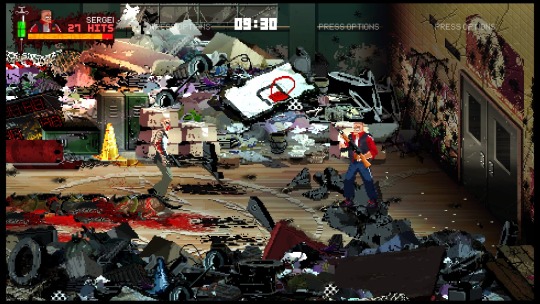
A scrolling brawler it may be, but after the gloss Streets of Rage 4, it’s clear the two couldn’t be any further out of step tonally. The plot sits on top of an alt-1980s Russia, and revolves around a group of Romani street fighters out for revenge after being taken forcibly from their camp to be used as guinea pigs for a highly addictive, hallucinogenic drug... that just happens to grant them super-human strength. Smooth and sanitised this is not; the pixels are out in full force, and gritty, needle-fuelled ultra-violent thuggery is the order of the day. The tutorial running you through its range of moves is a succinct highlighting of this, where the first time you kneel in front of and pummel a blood-soaked opponent to death is handled in a way that’s genuinely quite striking, and yet is but is utterly inconsequential as you move on to fight your next. Weapons just crank this up tenfold, with chainsaws, grenades, rifles and the like having results akin to their real-world equivalents - with environments often left as a bloody mess of corpses, rather than a pretty picture with the aftermath faded from view.
The action is fast, almost frantic at first impression, but after some time adjusting, it begins to feel much more by intention, and manageable too. There’s a few options to mix up your combo endings - like pushing people back, or launching for a few more hits, but make no mistake that you’ll be focused more on crowd control by numbers rather than finesse. There’s a few neat ideas coming out of some of the game’s set pieces, and bosses are typically less dependent on your typical straight-up fighting skill, instead relying on your ability to determine the mechanical gimmicks needed to beat them - and this leads to them breaking things up nicely. The lack of one-on-one finesse might have been an initial detractor, but as the battles became bigger, and the stages became more interesting, I felt like the game came far more into its own. The game’s hard cocktail of downtrodden types pushed through a backdrop of sex, drugs, and violence feels a little too try-hard in places - and one does wonder how closely the team involved had been looking at Devolver’s other output before pursuing the theme - but it doesn’t take too much away from what’s actually a pretty refreshing example of this type of game.
2 notes
·
View notes
Text
June '20
Trials of Mana

Maybe not the highest profile remake Square-Enix have put out in recent memory, but one that was pretty exciting for me. I played a fan translation of the Super Famicom original some 20 years ago, so while it's not particularly fresh in my head, there's just enough there to enjoy some infrequent little pangs of nostalgia. The move to 3D has made for some welcome changes to to combat - jumping adds a vertical element to combat that wasn't present before, and enemy specials being clearly telegraphed and avoidable puts a little more control in your hands. There's still a good amount of 16 bit jank though - combo timing feels unreliable, the camera's often a pain, there's plenty of questionable hit detection, and you definitely wouldn't want to leave your fate solely in the hands of your party's AI. Willing to put most of this aside, what actually mattered more to me was that it still had the kind of playful, breezy nature, it looks and plays nicely, and that it progresses at a nice clip. Party selection will change the way you fight moment-to-moment, but only provides minor and very brief deviance from the main storyline, most of which is the kind of schlocky cartoon villainy that will have you looking for a skip button before it would illicit any kind of emotional response. But you know what? Overall, I still enjoyed it a lot.
So while it may not be revolutionising the action RPG, what it does show is that Square-Enix is capable of acknowledging their history of previously untranslated works, and that they also now have a pretty good template for getting a B-tier remake of such titles out in a reasonable timeframe. Where do I send my wish list in to, team?
Sayonara Wild Hearts

As a one-liner found on the back of the box, 'A pop album video game' is about as on-the-nose as it gets. The old "it's not for everyone" adage is definitely applicable, and its defiance of traditional video game metrics is not in any way subtle. How sophisticated is the gameplay? Not particularly. How long is it? Not very. But how does it make you feel? Now you're talking. It presents a simple but deeply relatable story of a broken heart, and leads from there with a catchy tune into a fast and colourful onslaught of new ideas, perspectives, and concepts. That is to say: it has the potential to make you feel all kinds of things.
One especially celebratory note was how well the game is structured to fit into the album structure it boasts about. Stages flow quickly into one another, and while shorter, more compounding numbers are often about introducing new ideas and themes, moving on to the next is a few simple button presses and a brief, well-hidden loading window away. Inevitably there are more standout stages, those that feel like the hit singles; the longer, verse-chorus-verse type joints that grant the space for more fleshed out visual story telling, and that smartly synchronise their percussive hits, soaring vocals and the like to appropriate beats of play. A lot of the gameplay can easily (and cynically) be reduced to "it's an endless runner", but to liken this to a cheap re-skin of a confirmed hit-maker is to wilfully dismiss so much of what it does better and so much beside. You can play it on damn near everything, and for the time it takes, it's well worth doing.
Twinkle Star Sprites

I've meant to play this countless times before. I've almost certainly passed it by while strolling through arcades, the Saturn version has never been hoovered up into my collection, and the PS2 collection this particular version belongs to - ADK Damashii - is no longer a cheap addition to anyone's library. The digital version of it for PS4 however was however recently on sale at a point that saw me receive change from a fiver. David Dickinson would be proud.
Having now credit-fed my way through the game's brief arcade mode, there's no doubt in my mind that the nuance of its systems are going to be glossed over in this rather ham-fisted appraisal. At least at face value, there's plenty of character and charm to appreciate in its colourful and cutesy style. As a two-player, vertically split-screen title, its a pretty clean break from a lot of a shooter's typical characteristics - rather than 6(ish) stages of hell, its a series of one on one battles - and all the better suited to 2 players for it. As enemy waves come at you, taking them out in chains can generate attacks to the other player; however if these attacks are too small then it's entirely possible they'll be killed off again, and an even bigger attack will come straight back at you. Think of a bit like competitive Tetris, but with shooting rather than puzzling. It's a neat and curious little game, that's likely best experienced properly, with a friend on the other side of the sofa to hurl abuse at.
Blasphemous

Let's get the lazy-but-effective description out of the way: it's a 2D MetroidVania Souls-like. You've got "that" type of map, definitely-not-bonfires and definitely-not-Estus Flasks. You are encouraged to return to your body upon death, the combat system is very reliant on parries and dodge-rolls, and there's even a dedicated "lore" button to use on every item you pick up.
While this likely sounds dismissive, it's more about addressing the elephant in the room. To give some context, these are both types of games that I love, and the end product here has done a pretty good job of bringing them together. The exploration is pleasantly open - gatekeeping is typically done less by specific items and abilities, and more by just which areas you're brave enough to poke your head into. It's a little bit of a shame that most of the new abilities have to be switched out for others rather than adding to a core arsenal of moves, but at the same time its base setup gives you plenty of ways to deal with any number of combat scenarios. This is of course best demonstrated by the boss encounters, which are wonderful affairs - big, gruesome, thoughtful variations on approaches to combat, which drop in at a nice pace to keep you from ever getting too cocky. The theming in general is wonderful, and the name is certainly appropriate - there's a lot of deep catholic inspiration in its gorgeous backdrops and environments, but then layered on top are some chilling elements of religious iconography, along with a cast of disturbing devotees and martyrs to sufficiently unsettle you. It's arguably a small intersection of the gaming population that it'll appeal to, but if you're in there, it's a real treat.
Death Come True

The first thing you see upon starting is the game's central character breaking right through the fourth wall to tell you directly not to stream the game or to share anything that might spoil the story. The first rule of Death Come True, and so on. I consider myself fairly well versed in such etiquette, so to then have the screenshot function entirely disabled for the whole game felt a little like being given a slap on the wrists for a crime I had no intention of committing. I don't envy the team trying to market it, that's for sure.
The reasoning behind this is clear at least - it's a game that is in total service of its plot. Consider a mash-up of a 'Choose your own adventure' book and a series of full-motion videos, and you're mostly there. Unless you were to walk away from the controller or perhaps fall asleep, there seems very little chance that your play time will deviate from the 3 hour estimate - which will certainly put some people off, but is understandable given the production values, and personally, quite welcome in the first place. In terms of replay value, there are branching paths that a single route will obviously skip: as an example of this, in looking up a screenshot to use in lieu of taking my own, I found a promotional image of the central cast, only to not recognise one of them at all. One thing that such a short run-time does ensure though, is that minute-for-minute, there's plenty of action; without wanting to speak about the story itself (rather than in fear of reprise for doing so, I might add), it kicks off with plenty of intrigue, shortly thereafter switching to full-on action, and then strikes a pretty fine balancing act between the two for its run time. It doesn't get quite as deep or as complex as I would've hoped given the team's pedigree, but I do like it, and think it'd actually be a pretty fun title to play with folks who normally don't concern themselves with games. By the same token, it's probably not for the 'hardcore' types looking for something to string out over dozens of hours.
Persona 5: Dancing in Starlight

After the generous main course that was Persona 5 Royal, I figured that I'd follow up with dessert. I did however wait until a weekend where I knew my girlfriend would be away, so as not to trigger any unpleasant flashbacks to looped battle themes, and the chirpy, indecipherable voices of Japanese schoolkids that made it so painful to endure as a non-gaming cohabitant.
Immediately, it's clear that very little has changed since Persona 4's take on the rhythm action genre. The core game, while still functional and fairly enjoyable, hasn't changed a lick. Perhaps the most notable improvement to the package as a whole is in scaling back on a dedicated story mode, and instead just having a series of uninspired but far less time-consuming set of social link scenes that pad things out. The biggest flaw is repeated wholesale though, in that trying to stretch out noteworthy tracks from a single game's playlist into a dedicated music game leads to repetition - and there is a much less prolific gathering of artists involved in remixes this time. I'd be willing to wager that it's a very similar story once again with Persona 3: Dancing in Moonlight, but I'm not about to ruin a perfectly good dinner to start with the sweet just to find out, if you'll excuse a second outing of the metaphor. Still, again compare these to Theatrhythm though - where Square-Enix plundered the Final Fantasy series in its entirety, along with spin-offs and other standalone titles to put together a library of music worthy for the one single game. Cobble the tunes from Personas 3-5 together into one game, and you're still coming up very short by comparison.
#trials of mana#seiken densetsu 3#sayonara wild hearts#twinkle star sprites#blasphemous#death come true#persona 5 dancing in starlight
1 note
·
View note
Text
May ‘20
Prequel Story of Detective Saburo Jinguji - Daedalus: The Awakening of Golden Jazz
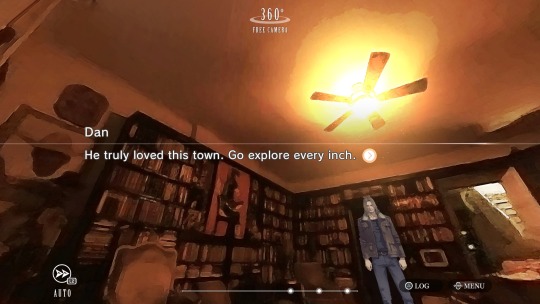
What a title. Ludicrous as it may seem, there is some value in closer observation though, as this is the same series that has previously reached the west under the ‘Jake Hunter’ name. This time however, it is labelled as ‘alternate’ Jake Hunter - so alternate that they’ve written an origin story and have taken to keeping the protagonist’s original ‘Saburo Jinguji’ name through to the English version. Sorry Jake, old boy.
It's still a story-driven title, one which has you jumping into Saburo’s shoes, back from Japan to New York to investigate his own grandfather’s murder. This has you revisiting the last case he’d been working, meeting with his friends and contacts, as well as catching up and reminiscing with pals from when you were last in the city. It's not too over-dramatic with its moment-to-moment story telling, and a lot of its bigger surprises are telegraphed a bit too openly, but the story is capable and enjoyable at least.
The visuals are quite unique, and are definitely one of the more noteworthy elements of the package. The environments appear to have been shot with a 360 degree camera, then filtered to shake out some of the detail. Characters sit on top of this as 2D cut-outs, stylised with distinctive but quite charmingly sketchy linework. It's not Rembrandt by a long shot, but at its better moments it does have a fairly unique, somewhat impressionistic look to it, while still providing the functionality to look around a scene fully for yourself.
Some of the rest of the design is much less effective; one example being the 'mind tree' - intended as a physical manifestation of deductions made, instead looking like alphabet soup. There’s a lot less thought in the audio stakes too - a lot of the tracks are not only re-used, but hinge on very short loops that permeate through a number of scenes without a concern for listener fatigue. The default volume for your button presses are bafflingly loud in the mix too, but at least this can be fixed from a visit to the options menu.
If the series were to continue and build on it, there's some decent foundations laid here. Some localisation issues - a number of very odd translation choices, and a space after every apostrophe being a particularly torturous error - and what is generally quite a brief and low-key story does leave this a little flat though.
The Missing: J. J. Macfield and the Island of Memories
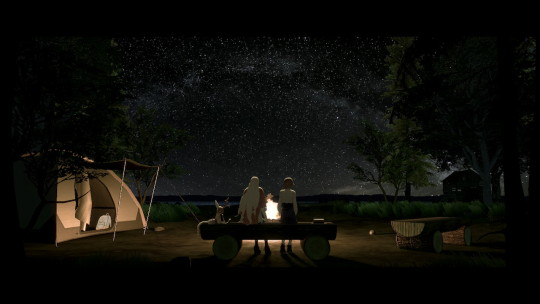
I swear I’m not picking games to play based on ridiculously long names, but here we are. SWERY is a designer who's very quickly established himself and his own voice in game-making, and even in what's arguably a more confined genre, he's still found plenty of opportunity to bring buckets of personality.
While a platform game at heart, it's more puzzle-based than anything - think more Abe's Odyssey or Flashback, rather than Sonic the Hedgehog. There’s a very striking duality to it too; conversation threads managed through your phone paint the picture of your character as a normal girl interacting with her friends, family, and tutors, whereas the gameplay in the forefront sets about immediately to paint a more nightmarish, decidedly macabre relationship with the world around her. There's a pretty serious story underpinning all of this which develops as these two worlds converge, and although it does remain fairly abstract, it does warrant a cautionary note. As J.J, the consequences you suffer are brutal, but not just when you fail, rather as mandatory puzzle-solving tools. Being electrocuted, burnt, dismembered and the like are necessary steps in precise sequences you need to execute perfectly to proceed. Perform one step incorrectly - which you will - and it's back to the start to repeat the self-abuse all while enduring its accompanying screams and suffering.
It's a surprising and thoughtful game - certainly a lot deeper than you might assume from a cursory glance at it - and although not an unreserved recommendation, is definitely a standout title in terms of ambition to do something different.
The Stretchers

There is something very strange to me about a Nintendo-published game having such a quiet reception. I remember The Stretchers cropping up on a Nintendo Direct one time, but aside from that I feel like there's little noise being made about this, when it's the kind of charming, family-friendly, couch co-op game that perfectly fills a space in the Switch's library.
You can, like me, an idiot, play this game through in single player. Your two paramedics are controlled by each side of a single controller, making this the perfect game for those who love to pat their hat and rub their belly simultaneously. Things may start easy enough, and even when the challenge ramps up, it's imposed more through diminished rewards rather than hard stops. But what I imagine to be a much more sensible option is the two-player setup, where each player takes on the role of one paramedic, and the challenge of co-ordination becomes more about talking, and I assume, mind-reading. The same relationship-ruining potential from Overcooked is here in spades.
In short, there's a hokey villain going about town, using his inventions to confuse people and have them lie about in a daze, and your typical assignment has you drive to a location, avoid various obstacles, load folks up on your stretcher, and cart them back to the hospital for fixing up. It'd perhaps be a serious affair, if the ambulance didn't handle like something out of Crazy Taxi, the obstacles weren't total slapstick, and every mission isn't bookended with your radio handler dropping puns like a writer's room full of dad joke enthusiasts.
In short, it's a lot of fun. If you have someone to play this with, you should.
A Short Hike
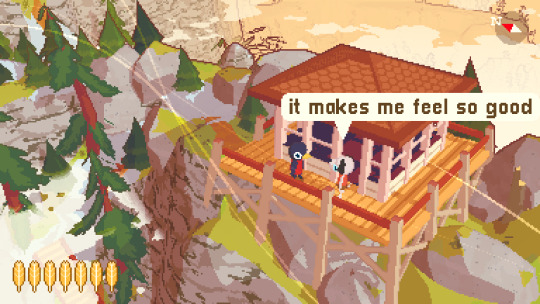
Just as with any kind of media, wider context is important when talking about games. This might not be the place to deep dive on the state of the world right now, but I feel a fair summary is that 2020 hasn't been a great year for many of us humans. Playing it today, A Short Hike feels like the right game for a wrong time.
It sees you taking a break on an island where your aunt works, and many other people (read: animals) visit, whether it's to paint, make sandcastles, or even run a race. The one thing you're missing - mobile phone signal - may come across a little incongruous from this idyllic getaway, but don't worry about that for now, and instead just let it do its simple job of pointing you to the mountain atop the island. Exploring various nooks and crannies, meeting people, and helping them along their way grants golden feathers which in turn allows you to traverse further - jumping more, climbing higher. More poignantly, they'll also have charmingly open little snippets of conversation to share with you. It's a really beautiful little microcosm of positivity - carrying the kind of whimsy that I imagine folks similarly look to the likes of Animal Crossing for. It's not a long or particularly arduous affair, but the struggle in making it to the top of the mountain, and the little celebrations I enjoyed on the way back down were the kind of life affirming shot in the arm that I didn't even realise I needed.
Dragon Quest

Yes, that one. It's probably important to state up front that I played the Switch version, as it's pretty clear that there are a lot of efforts in the name of modernisation which are more likely to upset fans than please them. Environment art has remained in its original format, whereas your character has shirked his pixelised warts in favour of a HD paint-over, for instance. There's a pretty obvious clash as a result, but at the same time, if you've never played it before and don't have a chip on your shoulder about accuracy, you may find this totally serviceable. Giving us nice HD enemy sprites may even make this an upgrade, even. So, I'll leave the comparisons for those who care enough to research them elsewhere, and instead let's talk about the game.
For something that's nearly as old as me, what feels like the biggest note to lead with is that with expectations set appropriately, it's still very good, and very playable. While a lot of important RPG standards weren't set till years after it, there are plenty of others which were likely quite groundbreaking as they stood here. I may be somewhat speculative on exact details there, rather than having the complete history of the genre mapped out - particularly given this is a revised edition - but I hope you can let that slide. So yes, a single party member with no personality to speak of following a very linear series of events may not be what folks expect today, but if you can understand that things happen over time, then there's a perfectly functional, plenty charming turn-based RPG at the heart of it.
Talking to NPCs might not be everyone's favourite favourite way to while away time, but once you realise they often tell you things of value and aren't just padding things out, you soon start to re-acquaint yourself with these less bombastic rhythms. Being far more vocal than your own character, this more recent translation has been given room for these village-dwelling NPCs to take on a bit of character too. The attempts at aping certain dialects may raise a smile, but similarly might frustrate if you're approaching this with English not being your mother tongue. Back-tracking and moving about the world is relatively painless, mainly on account of spells that do just that, and though yes, you'll likely need a spot of grinding here and there along the way, it's still short enough (about ten hours) to never get too arduous.
Thinking about the first games I played, then the first RPGs of this nature, when I played them, their relative levels of sophistication... it all highlights to me just how special this would have been to anyone who was there for this all the way back in '86. The start of an empire for good reason.
Dragon Quest II

... and here comes the sequel. The same pre-amble applies here; I don't really have the frame of reference to talk about pros and cons of the port here, so I'll be trying my best to think around that instead.
Straight off the bat though, you notice a lot of the big changes are incremental. Rather than one hero, you set out with three. Rather than fighting enemies one at a time, why not a whole handful? Dragon Quest ++ could be just as apt a title, particularly given the big change with the make-up of your party is the distribution of roles (the internet informs me this is the only DQ game where your main character has no spell casting capability) rather than the introduction of actual characterisation. That's not to say it's not lacking in charm - by jove guv'na, there's more of this bleedin' accent bizniss - along with Akira Toriyama's still-strong menagerie of monster designs.
It's a little bit longer, quite a bit bigger - heck - you even need a boat to get around it. Given the story is a continuation of the first game, albeit years later, there's even the opportunity to revisit areas from the old game on top of all of the new. This may all make things sound boring or derivative, but no, let's not get away from the fact that this is still plenty competent and enjoyable. The series may not have blossomed fully yet, but it's still an improved version of an already enjoyable game.
Dragon Quest III

Ok, NOW we're talking. Going between these games in a short space of time allows for some pretty conveniently direct comparisons - though I'm sure in future it'll also frustratingly blend them all together in my head too. Despite this, the jump between titles here is far more significant, and in almost every way for the better. That generational leap into 16 bit territory does wonders on all fronts; treating you to a slick intro (complete with graphics!), bigger and more detailed environments with a night/day cycle, more distinguished instrumentation in the soundtrack, and the doors blown wide open for the game to deliver a much bigger and less linear journey through the story.
The class system has seen a major upgrade too, and while you have autonomy on the makeup of your party, as well as the ability to later on mix and match abilities to make some wicked powerful allies, there is still the slightly disappointing note that as a result, these are total nobodies as far as the story goes. But overall things are just so much better; the game is much longer, yes, but it's also got so much more breathing space for there to be variation in how you tackle things and in what order. Minor discoveries and secrets can be found that are now just far enough off the given path that they do actually feel special. Personally, I've a huge sense of nostalgia for this era of games, and to tap into one that I missed at the time, and to still find it quite so fresh, was a pretty great feeling. Before anyone asks: no, I'm not playing DQ IV any time soon.
Blazing Chrome
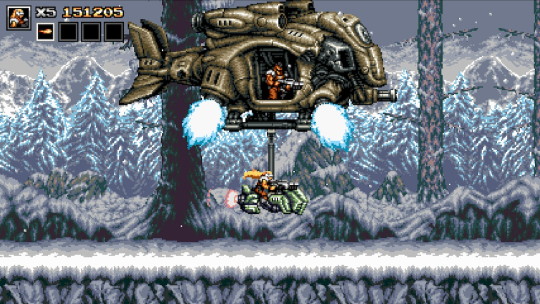
Let's start by being nice and labelling Blazing Chrome as a homage. If you've played the Contra games of the 90s, you'll recognise this very quickly, and in fairness to the game, it's not as if they're trying very hard to hide it either. The first level is a particularly unsubtle attempt to ape the opener from Contra Spirits, that unfortunately felt off by just enough for it to throw me. Out of necessity the sprites are bigger and more detailed, but the stage itself doesn't tap into the essence of its inspiration quite so well, rather decidedly plain and restricted. Later stages thankfully get a bit (not much) more colourful and ambitious.
Contra's never been famous for its ease, and here the moment-to-moment is just as merciless. Reckless play is punished quickly, and knowing what's coming is an advantage, but still one that's easily squandered if you don't time things quite right. So yes, your stock of lives is very easily depleted, yet the continue mechanism to balance this is overly generous - bringing you back to a recent checkpoint rather than pushing you to crack the level in one shot. Assuming you're willing to put aside that shameful credit-feeding chip on the shoulder, the game ends up being tackled in small sections, which although cheap, can still be quite tough in the later sections.
It clearly likes Contra's set pieces too - there's a few biking sections, some vertical auto-scrolling, a pseudo-3D on-rails bit - and while they're not all quite as enjoyable as one another, they're all reasonable enough distractions. It's clearly operating within guidelines not to do anything too fancy that doesn't fit its 16 bit aesthetic, but it also likes trying to replicate the moments and their graphical techniques that made games at the time special - bosses swoop by in full 'Mode7' style, and speeding through stages on a bike is accented by parallax-scrolled landscapes whizzing by in the background.
It's a fun, short game to breeze through that does perhaps lean a bit too hard on nostalgia to get the most out of it. Crucially, it's not as good as the titles it apes either, but it does serve as a convenient reminder of why they're great.
Cytus α

Good rhythm games tend to be fairly openly structured - play what you want, maybe get better at them, have fun. It's a core loop that can make good ones particularly addictive, and it's also why I find myself so dismissive of new ones that don't do anything inventive, or improve what's already out there. In this case, sorry, I'd sooner be playing Ouendan (or Elite Beat Agents).
In fairness to Cytus, I've done it a total disservice by playing with a controller, rather than undocking the Switch and tapping the screen as it so clearly intends - a bar would move up and down the screen in metronomic fashion, with the player tapping and dragging at circles rhythmically as they overlap. Whereas in my defence, I didn't fancy inflicting such intensive jabbing at the system, nor was the game ever particularly up-front about how it'd intended for me to play. Music choices are obviously entirely subjective, so I'll just settle for saying it's got a reasonable range of tracks that cater most regularly for electronic, dance-y numbers, that grabbed me rarely. It does borrow some music I knew I enjoyed from DJ Max - which seemed a good in-road, but sadly just highlighted it again; I'd rather be playing these songs in a different game. There's also a very in-depth but totally ridiculous story about AIs that I tuned out from in record time, but it does make for some neat key art that reminds me of the video to Bjork's 'All is Full of Love'. The actual UI sticks to a fairly minimal and monochrome theme, but during songs you're left with little more than a washed out background image while you play. It shouldn't be, and isn't important, but it's just another slightly lacking aspect of the game.
I've also still not found time yet for Voez or Deemo. Sorry, Rayark.
The Red Strings Club

Cyber-punky, drinks-serving talk 'em up. My mind expected VA11-HALL-A, and while they both do a great job serving up a tonne of cool-as-heck atmosphere, it's a much less passive ride here. There's some beautiful music; somewhat jazzy but sombre as heck piano scores the opening perfectly, but rather than just letting these moods wash over you too long, Red Strings Club drags you quickly in. The cyberpunk themes may not be anything new - a body-modifying big corporate is looking to modify existing products and over-extend its reach in the hope of enhancing human happiness - but it services the story as a backdrop quite neatly.
As a short game with a considered cast of characters, the fact you step into the shoes as a number of them as the story moves on allows for a very direct presentation of cause and effect. There's set pieces that are impactful, and real successes and losses to experience within them that weigh heavy as you carry on through. Donavan, the informant-slash-bartender, serves drinks that align to, and send his patrons down a particular emotional route. Make them feel a certain way, and they may get loose lips on certain topics - or they might shut up entirely. The game does a great job of drawing you into these conversations, giving you real cause to stop and think, highlighted in particular when you're then grilled afterwards to see just how much you grasped about them. Not just whether you understood the information exchange at face level, but also the sub-text of how they felt towards you, what's driving them, who they trust, and so on. At another point, a particular line of conversation steered into one character playing devil's advocate on one issue to the point that they ended up labelling my answers as being hypocritical - and damnit, they weren't wrong. Being both insulted and charmed at the same time was a strange feeling.
The story does a lot in such a short space of time, and is particularly rewarding given there were so many clear branching paths along the way. Somewhere between buying this and starting to play it, I forgot that it was from the team responsible for Gods Will Be Watching. I originally wrote a bit about that in 2016, and while flawed, it stayed with me as something I really enjoyed long after I sat down with it. I'm really pleased with this as their next move - it's just as considered and thoughtful, but without the balls-hard outer layer to bounce off. I think it's pretty special. Bravo.
#saburo jinguji#daedalus#the missing#j. j. macfield and the island of memories#the stretchers#a short hike#dragon quest#dragon quest 2#dragon quest 3#blazing chrome#cytus α#the red strings club
0 notes
Text
April ‘20
Persona 5 Royal
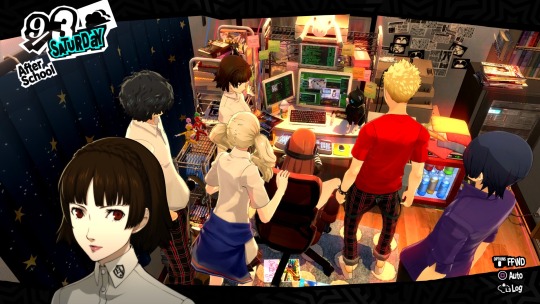
Having not even had the endurance to make it to the second dungeon of ‘vanilla’ Persona 5 when I played it in 2017, taking on an extended release like this felt like a somewhat foolhardy errand. Yet here I am, triumphant. Well... a week off from work squandered, my lockdown companion driven somewhat insane, and an in-game clock taunting me regarding 140 hours spent... perhaps triumphant is not the best choice of word, but let’s run with it for now.
P5 continues the bright, colourful mood set out in P4, complimented by some of the most memorable and gorgeous art I’ve seen in an RPG, and tied together in an array of super slick interfaces that I’m simply praying that other developers are taking notes from. The soundtrack runs smoothly alongside the game’s moment-to-moment beat, with jazzy vocal numbers being a common and pleasant accompaniment as you pootle about Tokyo and its shadow-inhabited underbelly. While tweaked here and there, the battle system is still a very familiar turn-based affair, with the upper hand most consistently being found in exploiting weaknesses to down groups of foes, but without overspending your resources. Building and tweaking your repertoire of personas is as complex as you care to make it, but totally essential as the quickest way to tune skills to your current needs and also to increase your overall power. Series veterans are likely be very familiar with most of this cast of demons by now, but to me at least this was less of a tired re-tread, more giving myself a headstart with a comfy pair of well-worn slippers.
As already noted, a single play through will certainly eat away the hours, and a lot of this can be attributed to the games’ focus on maintaining a social life around your world-saving antics. You’re given a decent degree of freedom as you do this, but it’s in spinning the games’ many plates of how to spend your time that you’ll find the most paralysing decisions to make and inevitably regret. This newly-released Royal edition does add another semester to juggle your time in, and in addition has done a good job of tacking on a new storyline that’s neatly woven into a tweaked base game. It does mean there’s even more moments when you are teased into thinking things are nearly wrapped up, but I see no concern in stating that this should now be considered the definitive version of the game.
Shooting from the hip, it’s a great game that’ll speak to a lot of people - it looks, sounds, and plays so very well, and is polished to the degree that most RPGs wouldn’t even think to consider. Story-wise, it’s plenty competent - very good even. There are involving plot lines, surprises along the way, and most of the characters are memorable, even if not likeable... and yet it is worth noting that some of it is fairly predictable, and nearly all of its more serious scenarios are still tinged with a quite saccharine sense of optimism. Villains both big and small lead you through a pretty heinous set of transgressions, and lead the game’s victims to some quite bad places, but the solutions that come out of these are typically quickly and cleanly executed, seeing these darker moods dropped just as swiftly in favour setting up the next. It also cribs some slightly cringe-y and overplayed anime tropes - most notably in every single character falling head-over-heels for the total blank-slate yet seemingly irresistible main character, leaving you to fill these boots, able to pick your love interest with all the relative challenge of picking from a takeout menu.
These are honestly the biggest holes that I can poke at here - that I prefer my story-telling with a bit more grit, my worlds painted painted in darker hues, and where decisions be thoughtful and nuanced. Preferences aside, I still had a great time with P5. Those with a more sunny disposition may fare even better still.
0 notes
Text
March '20
Outer Wilds
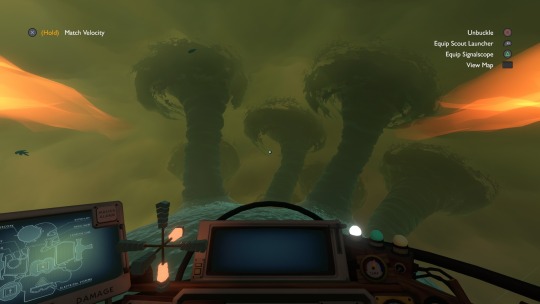
For all of its majesty and scope, space exploration and the science behind it is something that often gets dumbed down and glossed over in popular media, particularly when there’s a cool story about sexy aliens and all-powerful spaceships that wants to be told. Outer Wilds is... not that type of game. Within the first hour, the game’s entire universe opens wide up, and from there it’s a slow, lonely, and often gruelling journey of discovery, as you slowly piece together an understanding of said universe. Specifically; why you repeatedly experience the end of it in a 20 minute time-loop, and how it may relate to the fate of a revered yet now-extinct race.
While there’s a lot of very clever environmental storytelling and the odd character or two to come across, the most frequent source of knowledge comes from on-the-fly translation of ancient texts you discover as you bumble your way among various planets. It doesn’t sound particularly inspiring, but a world of dry scene-setting audio logs this is mercifully not. Information you take from these needs genuine consideration and retention (thankfully an in-game computer helps with the latter), and crucially, the comprehension to then put its learnings into practice. A friend kicked me off on my way with comparisons to Groundhog Day and Interstellar - which certainly make sense - but I also like The Martian here for its appreciation for the fundamental nuts and bolts of things out there in space. The passion for these astronomical pursuits ooze from every pore, and some of the most impactful scenes come from merely observing the incredible phenomena built into its range of diverse planets. One thing the game does very well is pairing these moments to its otherwise quite minimal score - one of my favourites being the soaring number that marks the end of each cycle, even despite it leading to a pavlovian response of panic as I would try to wrap things up before my inevitable death.
Tempering this somewhat, I will confess the above does present a somewhat romanticised version of the game. Laid bare, I was expecting a shorter, less obstructed run through it - that I wouldn’t be getting frustrated and dying repeatedly with awkward crash-landings, or that I wouldn’t be secretly pleading for stream viewers to offer a nudge in the direction that might break the mental deadlock on where I should be going next. Outer Wilds is a wonderful, thoughtful game, but one I appreciate far much more now that I have finished it, and that I don’t have to experience it through hours spent searching high and low to find the specific brick wall I was meant to have been bashing my head against. It definitely needs a little patience, but by golly is it memorable.
Murder By Numbers

I like to think that in most circumstances I’ve at least a reasonable frame of reference to present an informed opinion about games, but here’s one where I feel there is quite the gap. With hands very much up, let me confess; I had never played any Picross before this. While I found it easy enough to pick up, can I tell you where this sits among the grand pantheon of video game nonogram compilations? Can I heck. While I felt that the difficulty curve here was pretty steady for a newcomer, I certainly would’ve appreciated a simple UX option to wipe the board entirely and begin from scratch when you’ve made a mistake you’re not able to untangle. Not that I made mistakes and needed to do that, you understand.
The other core component of Murder By Numbers is far more familiar to me. Honor, your character, is first fired from job as an actress on a murder mystery show, only for the man responsible for the firing to turn up dead minutes later. Accompanied by newly-acquainted, amnesiac robo-buddy Scout, you begin to talk to those present, and seek out evidence (see: scan scenes and solve picross puzzles) to lead to the true culprit, which in turn leads to more mystery that plays out over another three chapters. On paper it could read as quite a morbid endeavour, but this is taking more from the Phoenix Wright playbook; it’s stuffed with charming, colourful characters that smile and laugh together and are generally very warm until the somewhat pantomime bad guys unveil themselves. Masakazu Sugimori lending his compositional talent helps further this comparison, and while their repetition can grate when you’re struggling to solve a puzzle, his tunes do carry the chipper vibe along nicely. It’s a well written, charming, and often funny game, and the combination with quite a laid back puzzle style like this leads to a generally enjoyable experience. Oh, and it’s here, right at the end, that I also remember that intro: if that doesn’t warm your heart, I don’t know what will.
2 notes
·
View notes
Text
February ‘20
Kentucky Route Zero

Kentucky Route Zero quickly became quite the obsession for me. Internally I'd downplayed and tuned out all of the praise I'd heard before, wanting a finished product to sink my teeth into rather than committing to a carrot on a very long stick. It became very clear that a lot of folks who'd been along for the whole 7-year ride of its delivery had their pens poised for this same moment, but moreso seeing a conclusion as the time to roll up all those years of gradual delight, and really take the roof off with their love. Thankfully, though slightly hyperbolic, I didn't bounce off any of this that I came across - instead, part of it presented a clip of a scene that immediately resonated with me as being one of the most touching moments I'd ever seen in a game. Now who’s dealing in hyperbole?
Labels are often useless, but here I see 'point and click' being used, and find it particularly ineffective; progression isn't held behind keen observation or cryptic puzzles. There are choices to make, but your role is less about steering the story forward in any one direction, rather more allowing you to flesh out the backstory and the characters in a role that's closer to that of a writer. The dialogue and the framing of each scene has a beautiful and intentionally theatric feel, and the prominence of the score not only contributes equal levels of brilliance, but also has others steering toward labelling it as a musical. Truth is, it was a lot of these things to me and more. It’s a crawling, melancholic reflection on ageing clumsily into irrelevance. A truly surreal and yet wonderfully grounded tale of a personal yet shared destination, all by means of an enigmatic and unknown passageway. Its main acts being so rigidly laid out into scenes helps define their place as mere snapshots from all of this, and their being punctuated with thoughtful and disparate interludes gives the opportunity to consider other perspectives and build context in a truly wonderful way.
This is very much my thing - it's one of the best games I’ve played in years. Made by just three people, I am floored with envy at what they have created.
Gris

It’s hard to imagine anyone having first impressions of Gris that don’t immediately focus on its visual design. Even its modest beginning with a more sparse palette is captivating, and more colours being introduced into its world as you progress may be symbolic, but a sincerely pleasant reward too. This isn’t quite as celebratory as say, Okami’s restorative moments, but it’s certainly taken its fair share of inspiration. Gris is captivating in motion too, with simplistic but beautiful animation really bringing its watercolour looks to life. I’ll put my hands up to say I was expecting it to be quite shallowly superficial as a result - for the game to dry up quicker than I’d have liked, and for me to perhaps get a little bored. To my pleasant surprise this was not the case - there are some skills to learn, and some mechanical depth associated with them that comes as you get further in, but it honestly felt more to me like the game knew what I was thinking - that perhaps it should hold back, stringing me along and saving its smarter puzzles and better level design for when it was most needed.
Piling on exposition lazily would certainly have jarred terribly, and thankfully is not the case. However, there being no dialogue, everywhere being so sparse, and the few interactions with other living things being so clearly functional for its set pieces does lead you to delve into a mountain of subtext, assuming you want to take more away from it. Deprecated but self-resembling statues serving as checkpoints between areas, and a world stripped of colour may not be the most subtle of metaphors, but I personally found there’s too little to connect to or contemplate about to say much praiseworthy on this front.
It is a nice little game - just the right kind of length, and truly beautiful to behold. While not a breakthrough, or as powerful as I feel I’d have liked it to be, it’s engaging and pleasant enough as a platformer, if nothing else.
River City Girls

Loud, bombastic and colourful, River City Girls is not a subtle game. While I’m not the most versed in the series’ deeper lore, I don’t think you need to be to tell that gender-swapping what’s essentially a damsel in distress storyline has been seized as an opportunity to shake up more than just the character sprites.
While perhaps not the best start that its primary characters are intentionally portrayed as being brash and classless, it is a fairly snug fit among the cast of countless other River City denizens. There's really very few of which that aren't met fist-first, and even the remaining designated oddballs and caricatures on the fringes are only there to help push a very simple story along. The quality of pixel art and animation in the forefront are both commendable and consistent though, with the UI and cut scenes taking on a stronger manga influence but blending in slickly. The brawling is entertaining, and learning additional moves can lead to some fun but admittedly quite limited combo potential. Unfortunately I didn’t get the chance to push this with a second player, but I can definitely see this being a favourable way to experiment. The boss fights are pleasantly varied, and while these can be a little stand-out in their toughness, strategising for them and nailing these does help break up the slugfests needed to reach them. This may all seem like fairly low-key praise, so it’s perhaps worth me highlighting that I did really enjoy this - these types of 2D brawlers are often seen as belonging to a bygone age, and are particularly uncommon when looking for this level of polish on top. There’s a really satisfying effort on the musical front too, with a pop-punk title track, some well themed stages, and even some boss battle chip tunes courtesy of Chipzel. If nothing else, it’s a superb fill-in for those who are still mourning the loss of Scott Pilgrim’s last-gen outing from digital storefronts.
2 notes
·
View notes
Text
January ‘20
I felt like trying this for a bit again.
Untitled Goose Game
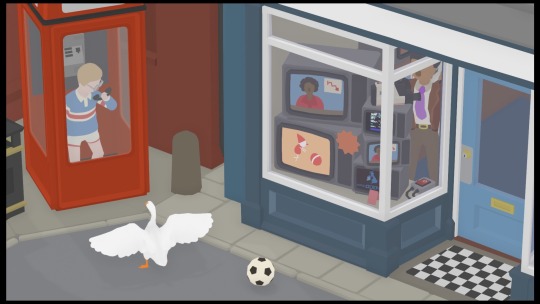
Where Journey and its ilk blew up the idea of a short, single-visit game, Untitled Goose Game feels closer to the next evolution of this ultra-focused style of design. It’s a perfect elevator pitch of a game - surmised exactingly in its abstract, and not even needing to commit to a ‘proper’ title… and yet more immediate and relatable than countless other games. Your aims are clear and simple, and a compact suite of commands elicits a range of responses from its environments and characters to help you achieve them. How one begets the other is just logical enough to work for its two hour duration, but does suggest it’s unlikely to have had scope to go much beyond this without repetitive tedium, or becoming bewilderingly obtuse. That’s not to say that it’s challenges are totally intuitive, or even that it’s free of moments where janky controls entangle you - but again, you’ll easily endure through it given how briefly you’re expected to stay. The primal appeal of being a horrible goose is easy to be ensnared by, and is neither overdone nor worn thin, once again thanks to the length of it. Its elegance and charm complements the simplicity of it all wonderfully, and though not revolutionary, or pushing any particular aspect of the medium to new highs, the quirk, laughs and originality of it is the type of bottled lightning that is unlikely to be replicated any time soon. Honk.
Wattam
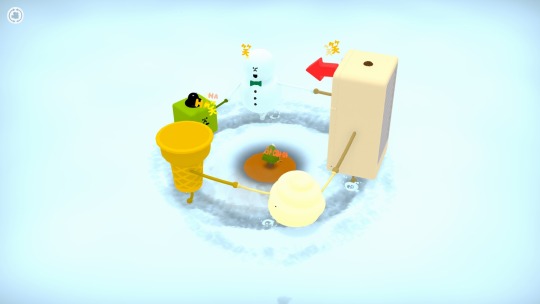
It’s a game by Keita Takahashi. You can assume plenty; warmth, charm, whimsy, colour, humour - and you’d be right. Divorced of a big studio and the legion of other talent that comes with it, his solo work continues to be mechanically light and missing a few layers of polish, yet is simultaneously far more experimental and groundbreakingly humane than most anything you could care to mention. Trying to explain in regular video game terms what you do is somewhat redundant, but to at least give it a shot; you play a large green square - The Mayor - who’s initially alone, but slowly coerces its population back, repopulating the world through various interactions within it.
I’ll be straight with you: I’ve had to rewrite this passage, as some of the first sessions I spent with this drove me up the wall and lead to a less-than-favourable commentary. Fully aware that talking predominantly about how it plays was “doing it wrong”, I nevertheless took to highlight how I found the camera frustrating, the characters’ erratic and independent movement to be testing, and the rapid-fire sampling of children’s cries laid over the jazzy background music to be cacophonous and anxiety-provoking rather than joyous. That I persevered and made it through the rest of the game is not to say I don’t still harbour some negativity towards it, but the last portion of the game did do a far better job of bringing me around to its charms than those earlier moments where I felt a bit too much like I was wrestling with it. I knew I wanted to see it all and to love it; the idea of being on the outside of something so light being quite so glum, but it didn’t come quite as easily as I was expecting. Don’t be too put off, but perhaps don’t also expect it to be completely painless either.
Neo Cab
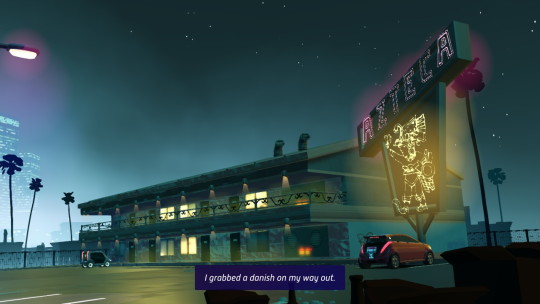
Neo Cab’s setting shines a miserably relatable light on a dystopian city and the people living within it. There’s an increasingly downtrodden population of gig economy workers, a police state whose corporate favouritism is not remotely subtle, and a growing number of people whose sentiment against this climate is rallying them together, and turning to action. There is not a lot of digging required to expose the game’s politics, or to join the dots to whom it really wishes were held to justice.
Normally when talking about visual novels, or even just narratively-focused ones, I tend to find myself on the back foot, expecting folks to turn off, and having to find ways to walk it back to more traditional game tropes. Here, I was actually quite pleased with how well Neo Cab defies any lack of interaction - to the point where I’d actually be pretty comfortable recommending this to near anyone. A big component of this is set up early on; a wearable device is forced upon your character that visibly broadcasts her current mood for all to see. As well as mood limiting what you’re willing to say (crucially though, not stopping you from contemplating these options), it’s also un-conveniently right there on her wrist for folks to see when they’ve hit a nerve. As a cab driver by trade, branching dialogue options you need to assess are incredibly frequent - and give your cues are often assuming, intrusive, or just plain rude - your management of them becomes all the more immediate and crucial. Ride quality influences your rating as a driver as well as your income, which in turn impacts which rides you can take, who you can meet, and who you can rely on in future. Sometimes your choices are simple, whereas other passengers may be more obtuse, or inadvertently land you in a quandary more moral in nature. It’s not a long game, and while I naturally don’t want to say too much, it does a good job of keeping the focus grounded on its key characters, who really make it all tick over nicely. I thought Neo Cab was pretty great - it’s got a simple but stylish look to it, and gives you just enough to think about.
Demon’s Tilt
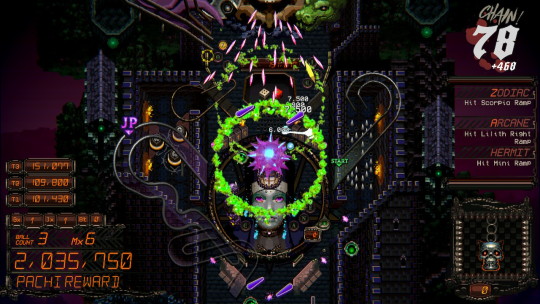
Pinball tables may not have changed much in the layman’s eyes over the years, but video game versions certainly have. In paying quite unsubtle homage to Naxat’s series of tables that blessed a number of 16-bit systems, the passage of near three decades has given Demon’s Tilt plenty of space to grow into. Larger, higher resolution screens gives us bigger play spaces and more detailed imagery, while increased technical grunt lends itself to a seemingly limitless crescendo of frenetic, often incomprehensible action. I mean, why not throw a little bullet hell into the mix? Goodness grief.
Given my particular fondness for Devil’s Crash, which to Demon’s Tilt is the clearest, most singular inspiration, I was naturally drawn to this. I’d played a little before in early access, but a more complete Switch version was appealing enough to revisit it. I was already safe in the knowledge that it’d managed to build upon and flatter my favourite pinball game without reducing itself to an imitation, but the option of portable play (with a FlipGrip, even) was particularly exciting. As it happens, trying to condense so much to a small screen wasn’t quite such the modern convenience I’d hoped - it’s a neat showcase, but quite impractical to actually play with. Not thrusting yourself within an inch of the screen and having to squint may give a smidgen more a fighting chance, but a bigger display also allows you to appreciate the slick blend of neon effects spewing themselves over the striking gothic imagery. The music contributes yet more welcome intensity to things, and though I’ve begrudged a few near misses and unfortunate bounces, in calm retrospect it’s clear the this is far more a reflection of my skill rather than any lack in ball physics. For those who are practised in ways I am not, the table itself has plenty of opportunity to flex your muscle, but even though my games aren’t the feats of endurance I’d wish for, I’m still coming away each time clamouring to go straight back in.
198X
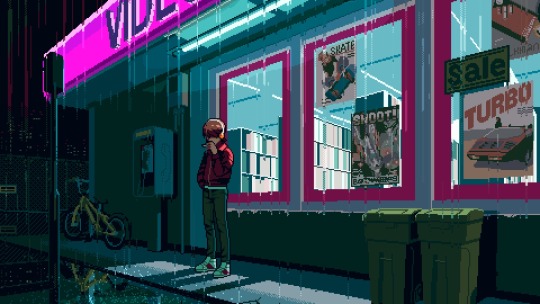
I missed this game’s crowdfunding attempts, but after seeing its trailer - a moody and romanticised nod to all things 80s arcade culture - it was very clear this was making a direct appeal to my sensibilities. It’s a coming of age story about a bored suburban teen, whose discovery of the local arcade ‘changes everything’. Now, I love arcades far more than most, but even I found the story to be over-egged. The Kid’s monologuing through the game’s cut-scenes jumps at such breakneck speed that it genuinely made me feel uncomfortable about their state of mind. Pre-arcade, all is miserly and monotone, whereas the escapism they indulge in after this discovery is worryingly unhinged. The pixel art propping them up may be quite tasty, but I think most people will find the story being pushed to be a touch cringeworthy.
The game that’s book-ended by these scenes are actually a series of mini-games, each clearly inspired by a particular 80s title. In short clips and stills, you could be fooled into thinking these are not just dutifully upgraded, but maybe even improved homages to the given classics. Visually, yes, there is some argument to be made here as there is some terrific pixel artistry being conducted here, but as there’s only about 15 minutes of each to play, it’s no surprise that some corners have had to be cut. Generally speaking, the balance of each isn’t quite so nuanced, and unsurprisingly this leans towards them being easier than you’d expect, but there’s specific shortcomings in each too. For example: definitely-not-Final Fight has some shocking collision detection, and of particular disappointment for myself, definitely-not-Outrun has but one gear, and hardly any impression of speed. While not fatal flaws, my point is simply that you’d not choose to play these over the original games they intend to pay their respects to. A second part being teased at the shortly-reached end is likely a downer for those expecting value, but I think it’s two-hour runtime is probably just about right considering it’s best viewed as a novelty.
0 notes
Text
2016 in list form.
In 2016 I tried to address the balance of games I play through to completion versus those which I buy and that live out their lives sat on a shelf in shrinkwrap. I honestly didn’t anticipate going quite so overboard with the number of games, nor did I expect to continue writing up everything that I played, but with all things considered, that is fairly low on the list of surprises that the year brought. I don’t know if or how this will all pan out in 2017 just yet.
I would however like to say a very sincere and heartfelt thanks to anyone that’s taken the time to look at, comment on, and share these - although this was very much a project for myself, there’s been some quite lovely feedback along the way which has helped a lot in moments of waning motivation.
So, aside from the somewhat obligatory cherry-picking of highlights among those that I already did write about, I wanted to call out a few other things that ate up time along the way. Lots of words and no pictures this time though, I’m afraid. You have been warned.
I’ve started but I won’t finish:
Downwell was great but good grief is it tough. Trying to get up to a reasonable level in a new roguelike was never going to be either quick or easy, but when there’s not even any opportunity to practice new areas, going the distance is going to remain a very tall order for a long time to come. I had wanted Aragami to be Tenchu, and it really isn’t; it’s a little too frustrating and clunky and I’m walking away for now. I hoped SuperBeat Xonic might capture the magic of the earlier DJ Max Portable titles, but it sadly didn’t - the core control scheme bugged me, and none of the music grabbed me enough to endure it. Enter the Gungeon was on my radar from a number of friends playing it a lot, but again, the time commitment of getting up to scratch with another roguelike meant I dropped it before it really clicked. Another attempt at playing Titan Souls still left me feeling a little bored and annoyed at the time it expects you to throw at it in between attempts to climb a near-vertical difficulty curve. I love N++ and maybe one day I will finish it, but good grief there is just so damn much of it.
Non-new things that I played a lot of:
I feel like I could be playing Spelunky forever, and I am still delighted by the prospect. Sticking in a daily challenge score is a regular highlight to my day, particularly so when I beat my pal Matt. In a weird twist of fate, a Beatmania IIDX cabinet showing up in London meant that I have enjoyed catching up on that series, and trying to remember how to be somewhat decent at it. Lastly, even though the obsessive levels of play are definitely done, Final Fantasy XIV: Heavensward still remains a nice little distraction for when a war-torn fantasy nation is a still more attractive prospect than the real world.
Things that I’d probably rate if I’d got to them:
Despite how the trailers painted it, Doom looks like a decent call back to its roots as a no-nonsense affair, which I’m hoping to play soon. Knowing the size of it, Dragon Quest VII is something that I’ve been really looking forwards to and dreading in equal measure, and so far I’ve yet to buck up the courage to start it. I was really excited for The Silver Case all year, but the controls on the Mac version didn’t work out for my setup, so I’m waiting for the PS4 version instead. By adding more clear goals and tasks, and also giving it a familiar theme, Dragon Quest Builders looks like the way for this bitter and jaded man to finally ‘get’ the Minecraft mould those young’uns go on about.
Best games I played that were not released this year:
NieR is the obvious choice here; because oh my, what a game. Despite an absolutely stellar recent demo, I can’t shake the feeling that there’s still some work to be done in really impressing what made NieR into the sequel, but I’m still very keen to see the final product. Snatcher was great to finally play, and I think I enjoyed it moreso than Policenauts. Having got to the PS3 version at last, EX Troopers not seeing the light of day in the west seems all the more tragic, as it’s a great and incredibly stylish game. Finally, Bloodborne is another that was very satisfying to finally see through, particularly as I got to play with some good friends who made the ride that much more fun while also taking some of the sting out of its tail.
So, favourite games of 2016?
I’ve tried to whittle this down to ten, but I think I’m going to lose my mind if I try and push for a ranked order, so instead you’re getting it alphabetically. Ace Attorney: Phoenix Wright - Spirit of Justice was a brilliant return to form that did its usual magic of charming the hell out of me while making me want to laugh, cry, scream and shout, sometimes at once. Dark Souls 3 is a wonderful note to close the series out on; it really felt like the imagination came back this time while also managing to hit a nostalgic nail on the head just enough to make me feel things I was not expecting from a game of its ilk, but importantly, without cheapening things. Expecting an absolute turkey, Final Fantasy XV ended up surpassing my expectations a dozen times over - and for once I feel like it’s done enough for me to not be the only one who ends up singing its praises. I know that Hyper Light Drifter has had a number of tweaks since I played it, but even before this it was an absolutely magnificent effort. Impossibly slick and dripping with atmosphere, it takes a better stab at the action RPG mould than anything I can think of from recent memory. As I continue to play more and more (and more), it’d be wrong to not recognise Overwatch - which is just as polished in its balance and core game design as it is with its wonderful cast and charming sense of style. Although it doesn’t stand up to its predecessor, I did still enjoy Shin Megami Tensei IV: Apocalypse considerably. It’s a long, tough slog, but it’s still littered with wonderful designs and held up by solid fundamentals. I’m still coming down from having finished The Last Guardian earlier this week, and I’ve a feeling that my fondness for it will only grow as time goes by, and particularly so given the inevitably gruelling wait for the team’s next output. Undisputed highlight of the WiiU’s 2016 catalogue was Tokyo Mirage Sessions ♯FE, filling in the void left by Persona 5′s push-backs with super-sweet up-beat pop-y JRPG silliness - lovely. Because it’s stayed with me so, I’m including Virginia. Among numerous narrative-driven games I’ve played, it’s probably the most unique in terms of how you interact with it and are fed the story in return, and I feel like there’ll be a lot of folks taking inspiration from it for some time yet. Finally, Zero Time Dilemma. Closing out a trilogy of games with such an ambitiously complex and far-reaching plot can’t have been easy, and while it does mean that it’s perhaps not quite as mind-bending as those that came before it, being able to close everything out in quite such a way while still entertaining throughout is a hugely commendable task.
You made it! Well done, and again, thanks. Be well.
1 note
·
View note
Text
December.
Final Fantasy XV

I had a lot of reasons to be sceptical about this, but I decided to give it all the berth it asked for; I watched the anime, I watched Kingsglaive, and then I went in with an open mind... and after all that, it’s safe to say that I loved it. There are flaws; plenty of them, almost all of which come back to over-stretching ambition and trying to do too much, but the things it does well made the full experience far more enjoyable than I was expecting. Primarily, the four main members of the cast are all so enjoyable and convincing in their interactions with each other that it’s hard to point to a better example of comrades-in-arms from gaming, charmingly carrying you through even the most drab and frustrating moments. Even just driving about and doing quests was fun enough - I found it pleasantly reminiscent of something between Dragon’s Dogma and Deadly Premonition in these parts, where I lost hours just gladly succumbing to its busywork and taking in the sights. The story had me far more involved than I have been with a Final Fantasy story in a very long time, and when it went to dark places it was handled in a mature way; not trying to wring its hands and sanitise tragedy in some PG-movie way that has almost certainly been the case in the series’ more recent past. The battle system isn’t the best, particularly with the big set-piece battles that prioritise spectacle over function, but it’s still fun and there’s plenty of scope to play your own way even if it is a little hands-off at times. Unsurprisingly, the soundtrack is masterful, and it is one of the most visually impressive games I’ve ever seen. Ten years of development hell, of changing vision, platform, and staff, all had me expecting the worst, but by some minor miracle they pulled off an incredible end result.
Titanfall 2
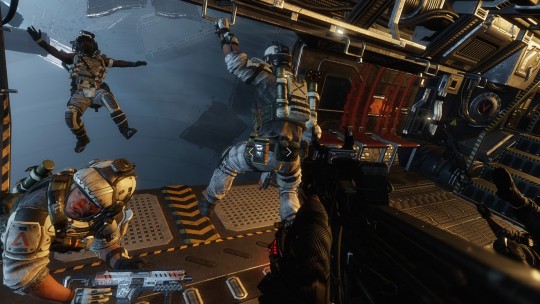
I respected the original, even if the multiplayer focus meant that I didn’t actually play it much. Somewhere between this one having a fleshed-out campaign mode, a load of unanimous praise heaped upon it, and a hefty pre-Christmas price drop, I figured I could give this a try. Its AAA polish is immediately obvious - slick cut scenes, smart designs, silky smooth frame rate, and paced in such a bombastic way that you never even have too much time to think about what’s happening. If you want to get into critiquing it you certainly can, but it certainly knows what it’s trying to do, who for, and it does it well - it also dabbles with some quite significant gameplay mechanics that it drops as quickly as it picks up, suggesting that there’s still some thought going into things even if it’s essentially "just” a refinement on the military shooter. While not so much my kind of game, it really does feel like a nice point to have poked my head in and taken a look at where the genre has got to. Plus, with its wall-running, knee-sliding, double-jumping action, it’s a game that really understands that momentum as one of the most base pleasures you can deliver in gaming. It’s not Vanquish, or even Bulletstorm in this regard, but it does still deliver some satisfyingly fluid action that FPS fans should be lapping up.
The Last Guardian

Well, it’s been a long time, but it’s finally here. You’ll hear folk talking of frustrating camera controls, the frequency of un-cooperative partner AI, even hobbled frame rates... and while they’re not inaccurate, these frustrations slowly fade from memory as I think back and remember the journey it took me on, rather than the grumbles along the way. In Trico alone, there’s the most convincing and legitimately lovable companions ever committed to the medium, which is enough alone to warrant a strong recommendation, even before you get to the stunning locations and set pieces that the adventure sees you through. While it’s quite unlike most releases, it certainly feels like iterative work for Ueda, particularly so with reference to Ico, however there’s something particularly refreshing in the dynamics of power - and in your lack of it - that really helps emphasise what’s so wonderfully new about it. The helplessness that this creates, and the patience that it asks of you as a player makes for an oddly paced, highly dependent, and therefore incredibly profound experience - one that certainly holds onto you after it’s done. Throughout all of his moments of misunderstanding, incompetence, and outright defiance, some bad words may have been uttered, but honestly, I loved Trico, the big lug. No game has ever made me feel quite so sad about not having any animals in the house to go and pet afterwards. Damn you, Ueda.
VA-11 Hall-A: Cyberpunk Bartender Action

What a lovely little game to wrap up the year with, and that coincidently, is also timed around the holiday season of 2016. Yes, it’s about bartending, but really, making drinks is such a trivial task that listening (er, reading) is the far more important task. Certainly during my brief stint as bar staff during university days, I do not remember being regularly besieged with good-looking, chatty clientele wanting to get to know me, being asked to concoct anything with more than 2 components, or even being given the responsibility of queueing up songs on the jukebox, but this is probably why we play games for fun and tend bars in the midlands for the money. So, a visual novel based on a pleasantly idealistic version of bartending. There’s some cross-over with the similarly charming Read Only Memories which I played earlier this year, including a diverse and progressive cast despite the world outside your immediate purview being painted as a fairly dystopian one. It’s also very openly sexual in a lot of its conversations, which I noticed but didn’t immediately shrink away from like a big prude - maybe I am growing up, after all. But on the whole? There’s no urgency to anything, and it’s just a nice, steady, pleasant way to while away some time and get to know some nice characters in a thoughtful world. Lovely.
3 notes
·
View notes
Text
November.
Chase: Cold Case Investigations - Distant Memories
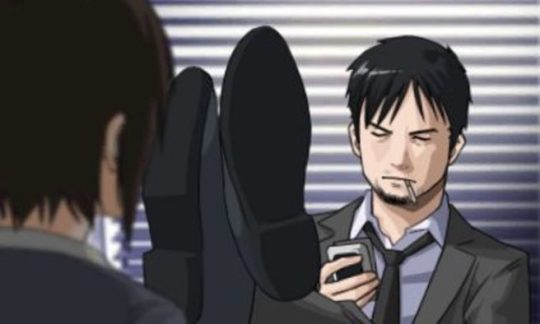
Even under a new guise, this team of ex-Cing guys have gone back to their assumed strength; a detective game. First impressions were pretty good: although it’s nearly all just character shots, they’ve got a nice look to them and they’re animated neatly. Unsurprisingly, the main character is a complete cliche - a grumpy, constantly smoking wise-ass - and whereas you might give the benefit of the doubt that he’ll develop well, there’s not really enough room for any such change. See, if you truly embrace your inner detective, the biggest question you might be left with is “where the hell is the rest of the game?”. The plural “Investigations” in the title might suggest there’s more than one investigation, but no - just as soon as the first wraps up, two hours in, the credits start rolling. If I knew this was episodic I wouldn’t mind, but... are there any other episodes confirmed? I honestly have no idea, the publisher hasn’t exactly been forthcoming about it either, and right now it’s just an anti-climatic tease of a release. Hopefully this is not the last we see of this.
Day of the Tentacle: Remastered

The first game that I ever saw demonstrated on my first home PC, folks! Whereas Grim Fandango’s situational 3D navigation and crappy Vita port (at least I hope that was the source of poor performance and regular crashing) didn’t help age it, the much more traditional point and click interface and off-beat cartoon style here make for a much smoother re-visitation. It’s still funny, not too long, and generally just a pleasure to go through. For my money, the pinnacle of the genre. I’m not really sure how much value the director’s commentary adds, but just as a way to be able to play the game on modern hardware, it does the job nicely.
Steins;Gate 0
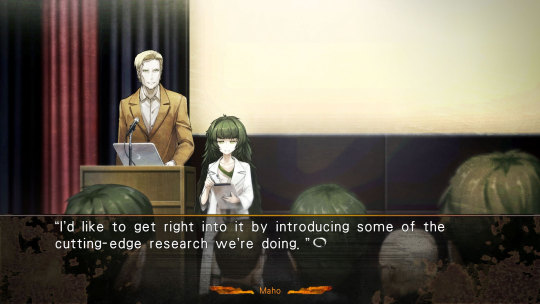
The original game was something that I loved dearly, but man is it a tough sell - a lot of the characterisation is quite irritating, and the game doesn’t really get going until about 8 hours in. Zero is a lot more immediate; throwing you in with key moments of the first game recapped (read: spoiled) right from the off, and major plot themes revealed quickly thereafter. The elevator pitch is that it’s an in-depth exploration of one of the bleaker timelines that the original introduces and then moves away from, which also signals a pretty huge difference in tone. It still jumps about between light hearted and serious though, and little’s really changed to the way it actually plays. It is very much more of the same; albeit with AI thrown in as the new sci-fi theme du jour on top of time travel one, and with some new characters stirred up in the mix too. It doesn’t upset the balance with either of these, and it has some brilliant story moments, but really, if you’ve made it through the first (and yes, you really should before even thinking about this) your mind will already be suitably primed for the kind of developments that come your way throughout the course. In a way it’s a shame that the expectation does temper the delivery, but I still enjoyed it a lot. Disclaimer: I was fortunate enough to be provided a review code for this, and if you know where to look you’ll be able to look at the product of that for more thoughts on it.
King of Fighters XIV

SNK may not have the greatest of track records when it comes to three dimensions, but unsurprisingly, XIV still plays like a 2D game, with that oh so distinctive KoF core - so it’s not that big of a deal, surely? Fan reaction to the first teaser might have had you believe that this was the ugliest game ever, and while I will not deny that XIII is a much more beautiful game, visually it’s still serviceable and has clearly afforded the team the ability to build a huge roster in a very short space of time. The way some of these characters look and interact with each other shows SNK clearly have a decent sense of humour, and there’s a load of old favourites along with plenty of new, and unlike Capcom’s much-criticised approach to SFV, there is a decent range of ways to make use of each of them from the off. Sadly, when I tried, 30 minutes of searching on a weekend couldn’t find me a single online game though, which does not bode particularly well for people looking to play this at any kind of decent level, that doesn’t already have access to offline competition. From what I’ve been able to eke out of playing against the CPU, I do like the systems in place, but even despite the ongoing support (a patch is due any day now which is meant to deliver a whole host of improvements) it’s once again looking likely to play second fiddle in the fighting game world to the flashy, big-money backed Capcom release. This, my friends, is a shame.
Legend of Dark Witch 2
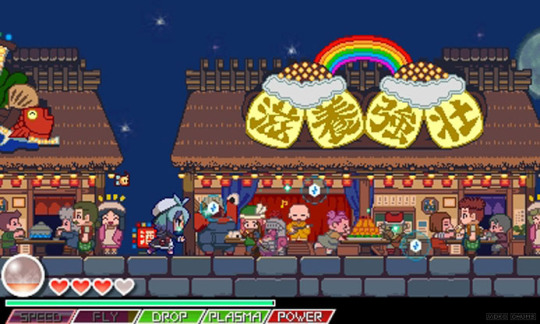
This had been on my radar for some time as a doujin game that had picked up the Megaman baton and ran with it. More so than some ‘spiritual successors’, it really captures the feel while still being plenty original, too - on top of some really detailed backdrops and beautiful sprite work, there’s a really neat power-up system that works very much like the one from Gradius. There’s a story - arguably too much of one - which is not particularly good, and that I’m hard pressed to decide if this is because of the very literal translation or just a load of generally badly written nonsense in the original script. Still, there’s a decent amount of stages, along with time attacks, hidden pickups, and a way larger pool of upgrades and power-ups to buy than you’d have thought necessary. A confession: I was all set to come here and tell you how easy the game is and that you can beat any boss (but the last) without having to learn how to dodge their patterns and just shooting quick enough to kill them before they return the favour. Then by chance I grabbed and played the original game, had the shock of my life, and then came back to realise I’d played number 2 on easy difficulty. Oh, the shame. So, ignore all of the above - there is some real challenge to this after all, and it’s a very nice little title to pick up and play if you were left a little broken over the sorry state of Mighty Number 9.
Overwatch

I’d played a little before with some friends over a free weekend, but another free weekend and a price drop on the full thing has meant that I’ve now spent a lot more time with this. It’s great. There’s a pretty similar vibe to this that I got playing Splatoon last year; it’s bright and colourful, and despite being an online FPS it’s managed to sanitise a lot of the interactions to breed an atmosphere that is clearly intended to be inclusive and collaborative rather than just going straight for a hyper-masculine, gun fetishist audience. It’s quite pleasingly skill-based, but perhaps even more key is party composition - particularly evident when playing pick-up groups and predictably having to fill in key support roles as everyone rushes to pick their favourite offense hero. That necessity for balance can’t really be over-stressed enough - there’s characters here that quite intentionally cater to alumni of any number of specific FPS games, but knowing the meta of who counter-picks who, and when each of them works best is so critical. Community gripes aside, where it falls down hardest though is in its lack of variety; there’s only a small number of game modes and maps, and whereas over time this will improve it’s definitely best suiting my own gaming schedule as a brief but regular check-in, rather than something to dedicate my time to extensively. Blizzard’s level of polish, as ever, is absolutely stunning - there’s so many neat little touches and considerations, and the shorts they’ve put out to build up the world are great. For a game so clearly focused on its characters, it’s actually quite the shame there isn’t more opportunity to expand on them in-game. Hopefully this is just the first step, though.
#chase: cold case investigations#day of the tentacle#steins; gate 0#king of fighters xiv#legend of dark witch 2
1 note
·
View note
Text
October.
Virginia
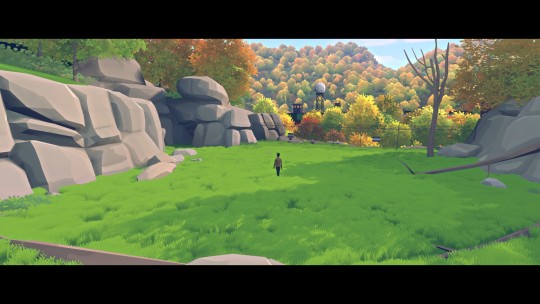
Virginia sold me by way of name-drop; it’s taken a lot of inspiration from things that I care about, and has no qualms with making that known. There’s a letter from the team to read from the main menu that says that they had aimed to create a strange thing, and I will give them that much. The elephant in the room is that despite its story being a complex one, it is entirely without dialogue, and with only very little written throughout. Now, I will gladly go to bat for the idea that less can do more, but stripping a script out entirely does bring its own share of complications. Despite its relentless pace, I tried in vain to focus full attention on picking up all of the subtext in the way people looked and behaved, at least giving me some way to speculate on the mysteries that were being woven around it. This was quite tough, but became less frantic an effort as I began to realise how liberally it jumped about its timeline, flittering between fact and fiction, and generally offering an unreliable narrative. See, I’m not sure I’ve ever played another game that is quite so cinematic in nature; immediately most obvious in its framing of each scene, but most notably in the way your input is just a diversionary glimpse within each moment rather than a means to fully explore it - sometimes even as part of a montage, and going so far as to skip things along when you’re not progressing at the pace it wants to move at. It’s very hands-off, and closer to a movie in length too, but just like my favourite kind of movie, it’s stayed in my thoughts much longer afterwards. There’s questions about what it says and what it means that I can’t simply answer - that might not even have answers - but to me at least, that’s part of why I was so intrigued in the first place, and one of the reasons that I enjoyed it so much.
Nium

15 minutes long at most, Nium is a brief little roam about a simple world, fighting a few different enemy types with a stick. Some you can just bash, others are flying and require you to throw your stick to knock them down, and others need you to bait them into diving at you so that then you can throw your stick and follow up with a pummelling. It’s simple but fun, and despite being pretty lo-fi it’s a really neat proof of concept - it’s got a strong atmosphere about it, and I really like how everything moves as you spin the camera about. I’d certainly like to see a longer title fleshed out from the framework.
Rez ∞

The more I talk with people about it, the more I realise I am in good company when I say that I didn’t get Rez first time around. I played through the first four areas and walked away with a smile, just... not the wide open mouth and stunned expression that followed the discovery of stage 5. Since then, there was Rez HD, which gave me the whole experience over again with a newfound appreciation for it, and now we have this. Had I have played this version first time around, I’m not sure I would’ve needed that extra kick in the right direction to get it. It’s a massive cliché for a creator to say “this is the way I always envisioned it” when releasing an upgrade, but here I can let it slide - it feels honest and very true to what’s always bubbled under the surface. As a shooter alone it’s always been solid but hardly exemplary, but playing on the concept of synesthesia, of visuals and sounds all blurring into one experience, it’s always shone much brighter. Being able fully immerse yourself into it is such an obvious evolution of this; tracking head movements to aim is so intuitive and natural that the game is much easier to play and enjoy, and the wireframe world you traverse is stunningly immersive despite being so purposefully unreal. Area 5 in particular still blows me away each time, and the new Area X takes a lot of the concepts that one step further, allowing you to break free of your rails and move around in a quite overwhelming fashion, also bringing a lot of the life that pseudo-sequel Child of Eden introduced into the picture. At its most basic, It’s the best version of a great game, and on top of that for my money, it’s the VR killer app right now. Really, I can’t think of many things that would have even featured on my hypothetical ‘VR update wishlist’ as highly as this - and it’s going to take something special for people to stop listing it as the prime reason to take this new hardware seriously.
Thumper

An excellent accompaniment to the above, as despite their similarities, Thumper almost feels like the anti-Rez. They’ve both got a strong rhythmic element to them, yet whereas Rez is welcoming, open, and charmingly psychedelic, Thumper is a surreal and oppressive toboggan ride through a panicked hell-scape. I am sure that someone much cooler than I am has drawn a particularly insightful drug-based parallel for this. Mechanically it’s not too complex, but you will find ways of improving your score to then revisit old stages. Really though, the fun is found in the asks of the player at later stages, which require such dexterous reactions that just making it through is enough of a challenge. I think calling it a rhythm game rather than a music game is an important distinction too: yeah, I enjoyed the music in it, but it is pretty limited in its function to shape the mood and give you something to pulse along to with your clanks and stomps, rather than something you might expect to listen to actively. I found it consistently thrilling, though in the few times I’ve played it without VR, it’s not had quite the same impact, nor have I been able to replicate the same levels of success. Whether this is due to adjustments on the game’s behalf I couldn’t say, but it does seem to suggest that once you are able to comfortably process this type of sensory pummelling, immersion like this really does help games like this push on to a higher level.
Super Hypercube

It’s pretty universally accepted that the best puzzle games are easy to learn but difficult to master, and this is as simple an idea as is possible; spin a shape to fit into a hole. It’s not an original idea, and naturally it’s more difficult in practice - you need to work at speed, the hole’s often obstructed by the shape itself, and while it might start as a cube, it grows in size quickly and soon becomes massive and unwieldy - and yet interacting with it is so natural in VR that it is incredibly easy for anyone to pick up. Depth is palpable and convincing in a way that traditional 3D graphics would struggle to portray, and leaning around the room to peer above and around the sides of your shape is magnificently intuitive. The neon throbs and ambient hum of effects that theme the game do so excellently, and in all, I do have to tip my hat to Polytron for having such a perfect example of what VR can add to an old idea available at launch like this. Though it is enjoyable, it is quite limited though, depending on your own skills, the luck you have as your shape grows, and your patience to try again when it inevitably comes falling down. I normally don’t like to bring value into the conversation about the quality of games, but I feel it’d be disingenuous to not bring up that I did feel a little disappointed on realising that the basic mode is the entire game, and that the £25 price tag did feel a little steep due to this. I’ve no regrets, but it might stymie others.
Shin Megami Tensei IV: Apocalypse

As a direct continuation of one of my favourite RPGs in years, this had a lot to live up to. Certain parts really did - I like a lot of the revamps to combat, in particular the way that partners became meaningful additions to your team, and it does a much better job of throwing you straight into the thick of things without having quite such a savage difficulty curve. Let’s get this straight though - it’s still punishingly hard when it wants to be. I can forgive re-using assets too - and there really is a lot of that, in the monsters, the locations, the music... everything, really. What’s important is that they’re all still great. Crucially though, I preferred the story in SMTIV regular - I had really loved how the main players were all quite redeemable people, just with enough differences in their thoughts and beliefs that made you really think about your own and about who you wanted to side with as things ramped up. Apocalypse doesn’t stir that same pot quite so openly; whereas there’s still choices to be made, it’s less about moral grey areas, and instead expects you to align to a much more clear-cut set of beliefs, that essentially boils down to whether you want to be an arse or not. Whereas it’s not quite Bravely Default, it does also suffer from going on longer than it probably should’ve done - I finished up at level 110, which seems completely excessive. It’s a nice accompaniment to IV, and in many ways its the better game, but it didn’t blow me away in quite the same way.
2 notes
·
View notes
Text
September.
Deus Ex: Mankind Divided
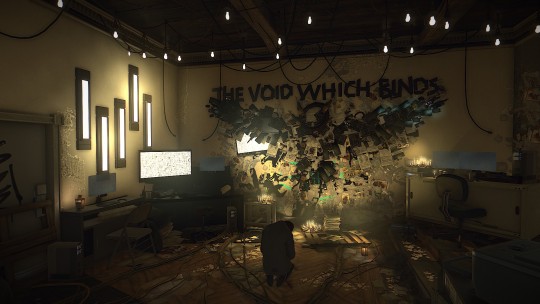
I thought Human Revolution was great, and I’ve been looking forwards to this a lot. In some ways I am surprised I like the formula, but I find it very easy to get caught up in its more inane busywork; hacking every terminal, opening every door, skimming every email, and so on. This is mostly down to the strength of its level design - where brute force is clearly an ever-present option, but methodically taking apart an environment, arming yourself with inside information, extra gear, shortcuts, and so on, proves far more effective and doubly so satisfying. It stumbles a little with some scenes not playing out as you’d imagine they should - particularly when there’s heavy reliance on the somewhat clunky AI - but when falling back to gunplay it’s typically still an easy enough task to stay behind cover, popping up to rattle off a headshot before then ducking back down to line up the next. A lot of the story’s tension derives from the social and political conflicts present in its world-building, which borrow liberally from real-world scenarios and movements, and yet it falls short of being able to say anything particularly meaningful about. Instead, to combat the opportunists and conspiracies that mire its world, it plays into the usual fantasy; the one man army that does it all, and either sneaks in and gives someone a stern talking to, or kicks the door right off its hinges and gives someone a “stern talking to” - which at the very least is your own choice to make. It’s unsurprising that some folks are putting the boot in for it being shallow in this regard, but even when rather abrupt, it is at least functional. I don’t think it hits the highs of Human Revolution; mainly down to having fewer hub worlds to globetrot between and quest in, but the main tenets of gameplay still kept me entertained, and the sci-fi teeters nicely on the boundary between plausibility and preposterousness to keep you thinking. What’s up, 3D-printed cities!
Everybody’s Gone to the Rapture
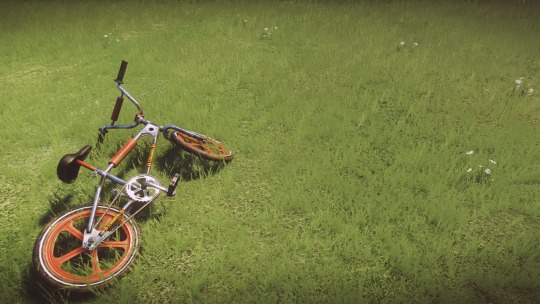
The definitive game set in Shropshire. In trying to set up a typical rural village, the scenery’s all incredibly quaint and beautiful, but ultimately a little quiet and dreary - and as someone who grew up near a lot of villages which probably fit the mould the team were aiming for here, there is a certain authenticity to that. What I found more interesting was how the focus of the story shifted throughout, and how much my attention moved with it. The opening section focused very heavily on setting the scene, which I found over-egged and quite weak. It does eventually start to move though, focusing instead on the stories of individual people, and I was pleasantly surprised at how well it eked out some quite authentic and touching human interest from what had been such a slow starting point. It did slightly lose me again towards the end when it started wrapping things up, but this didn’t hamper things quite as the opening had, allowing me to still be riding high come the finish. What remains on a consistent high are the visuals; it’s gorgeous, and I found myself reaching for the screenshot button throughout. Sadly even for this type of narrative-heavy game, it’s very short on interaction, but the even more frustrating thing is the pace at which it moves. Sometimes it feels like this could be for dramatic effect, and heck, it works in those brief moments, but there are many times more where it’s clearly just a restrictive and unfortunate side effect. It’s had a lot of praise over its soundtrack, which is understandable - on account of being quite regularly choral it’s not very typical video game music, which helps it stand out, but that’s not to say that it isn’t also very good. What probably helps the most though is its sparing usage; saving itself for short, punchy accompaniments to some of the strongest scenes really carries it home. A nice few hours can be whiled away here, but bring plenty of patience with you.
Assault Suit Leynos

Less of a by-the-numbers ‘HD remaster’ you see of PS2/3 games, Leynos is a ground-up remake of the Megadrive game which shares its name. Rather than making the obvious jump to shift everything to 3D though, there’s still plenty of lovely chunky sprites to look at, which is a popular choice with me. It’s pretty simple in its execution - play as a big mech, stomp about, shoot things, sometimes protect things. As well as the radio chatter making you feel like you’re in a (insert mech anime of choice) movie, it’s important to note just how significant the weight and feel of your movement is. Being able to boost about in limited bursts for speed is handy, but though there’s sluggish heft behind every step, it is far more satisfying than it is ever frustrating. One of my biggest complaints and the biggest shames is that the melee attack doesn’t carry that same oomph. Anyway; your shields regenerate at quite some pace, which lends itself to a uncommon but fun rhythm of heavy fire and shield usage regularly interchanged with one another. Once you’ve gotten into this beat and figured out how the game wants you to play, it’s not a particularly long campaign, but that doesn’t feel like a problem. Really if you’re to take issue with either this or anything else, it’s worth remembering that it is almost certainly there in the first place by design. Despite having only ever been a small sub-genre at its highest points, there is so little effort here to modernise; instead it just gets itself rutted in for those who do dig its heritage. Bless it.
Ace Attorney: Phoenix Wright - Spirit of Justice

I enjoyed the last instalment in this series, though it had made me question whether it could carry on without a steady decline; if perhaps a shake up was necessary. So in its defence, you could argue that here there is a new system during trials, which does serve as an interesting diversion... though in reality, it is not anything truly groundbreaking. But far more importantly, the game at a higher level is the most glorious return to form imaginable in the writing and story-telling departments - and as it turns out, I’m just fine without the series trying to re-invent itself after all. If you’re a veteran, the oh-so inevitable locked room murder mysteries won’t seem as daunting, you’ll likely deduce some of the bigger revelations way before the cast does, and this is not to mention it almost being a certainty that you will have most of the new cast members pegged from their first introduction. But the journey itself is what’s consistently brilliant, with the standard of the localisation in particular being a delightfully funny turn-around from the functional yet error-plagued mess that was the last. The music is as charming and catchy as it’s ever been, and the depth of characterisation to be found simply in the way that each character is animated is just wonderful. I’d still love an English version to see what series creator Shu Takumi’s got going in with the ‘Great Ace Attorney’ spin-off, but as it turns out, his baby is still in wonderful hands.
#deus ex mankind divided#everybody's gone to the rapture#assault suit leynos#ace attorney spirit of justice
2 notes
·
View notes